Planning for Growth: A Case Study of TXO Systems
VerifiedAdded on 2024/06/13
|28
|5908
|393
AI Summary
This case study examines the growth strategies of TXO Systems, a leading supplier of telecom network equipment. It analyzes key considerations for evaluating growth opportunities, including competitive advantage, innovation, and collaboration. The study applies Ansoff's Growth Vector Matrix to identify potential growth routes and utilizes frameworks like the BCG Matrix and PESTLE analysis to demonstrate TXO's competitive advantages. It also explores various sources of funding, including bank loans, crowdfunding, angel investor funding, and venture finance, evaluating their benefits and drawbacks. The case study culminates in the development of a comprehensive business plan for growth, outlining strategic objectives, strategies, and financial information. Finally, it assesses exit or succession options for small businesses, comparing and contrasting different strategies and providing valid recommendations.
Contribute Materials
Your contribution can guide someone’s learning journey. Share your
documents today.
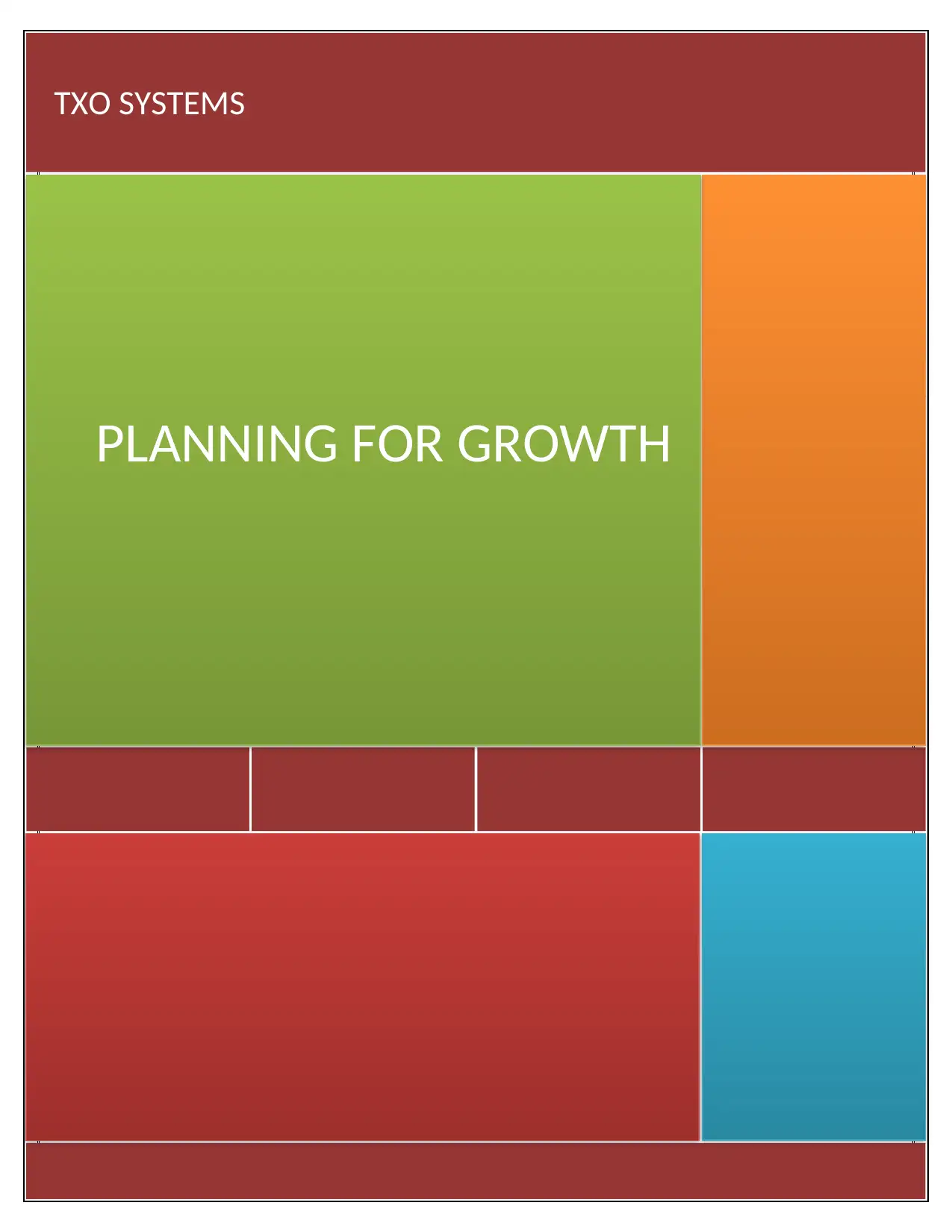
PLANNING FOR GROWTH
TXO SYSTEMS
TXO SYSTEMS
Secure Best Marks with AI Grader
Need help grading? Try our AI Grader for instant feedback on your assignments.
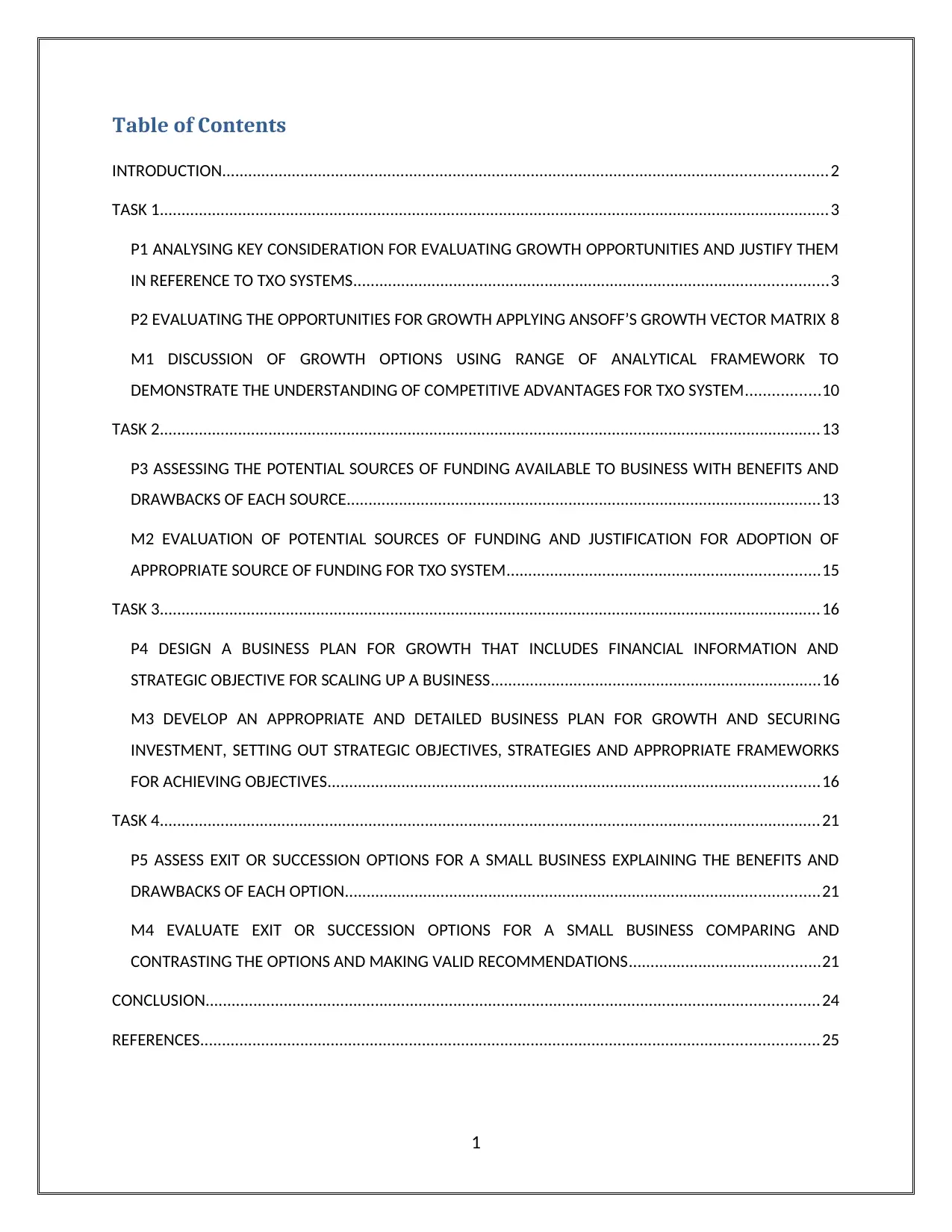
Table of Contents
INTRODUCTION...........................................................................................................................................2
TASK 1..........................................................................................................................................................3
P1 ANALYSING KEY CONSIDERATION FOR EVALUATING GROWTH OPPORTUNITIES AND JUSTIFY THEM
IN REFERENCE TO TXO SYSTEMS.............................................................................................................3
P2 EVALUATING THE OPPORTUNITIES FOR GROWTH APPLYING ANSOFF’S GROWTH VECTOR MATRIX 8
M1 DISCUSSION OF GROWTH OPTIONS USING RANGE OF ANALYTICAL FRAMEWORK TO
DEMONSTRATE THE UNDERSTANDING OF COMPETITIVE ADVANTAGES FOR TXO SYSTEM.................10
TASK 2........................................................................................................................................................13
P3 ASSESSING THE POTENTIAL SOURCES OF FUNDING AVAILABLE TO BUSINESS WITH BENEFITS AND
DRAWBACKS OF EACH SOURCE.............................................................................................................13
M2 EVALUATION OF POTENTIAL SOURCES OF FUNDING AND JUSTIFICATION FOR ADOPTION OF
APPROPRIATE SOURCE OF FUNDING FOR TXO SYSTEM........................................................................15
TASK 3........................................................................................................................................................16
P4 DESIGN A BUSINESS PLAN FOR GROWTH THAT INCLUDES FINANCIAL INFORMATION AND
STRATEGIC OBJECTIVE FOR SCALING UP A BUSINESS............................................................................16
M3 DEVELOP AN APPROPRIATE AND DETAILED BUSINESS PLAN FOR GROWTH AND SECURING
INVESTMENT, SETTING OUT STRATEGIC OBJECTIVES, STRATEGIES AND APPROPRIATE FRAMEWORKS
FOR ACHIEVING OBJECTIVES.................................................................................................................16
TASK 4........................................................................................................................................................21
P5 ASSESS EXIT OR SUCCESSION OPTIONS FOR A SMALL BUSINESS EXPLAINING THE BENEFITS AND
DRAWBACKS OF EACH OPTION.............................................................................................................21
M4 EVALUATE EXIT OR SUCCESSION OPTIONS FOR A SMALL BUSINESS COMPARING AND
CONTRASTING THE OPTIONS AND MAKING VALID RECOMMENDATIONS............................................21
CONCLUSION.............................................................................................................................................24
REFERENCES..............................................................................................................................................25
1
INTRODUCTION...........................................................................................................................................2
TASK 1..........................................................................................................................................................3
P1 ANALYSING KEY CONSIDERATION FOR EVALUATING GROWTH OPPORTUNITIES AND JUSTIFY THEM
IN REFERENCE TO TXO SYSTEMS.............................................................................................................3
P2 EVALUATING THE OPPORTUNITIES FOR GROWTH APPLYING ANSOFF’S GROWTH VECTOR MATRIX 8
M1 DISCUSSION OF GROWTH OPTIONS USING RANGE OF ANALYTICAL FRAMEWORK TO
DEMONSTRATE THE UNDERSTANDING OF COMPETITIVE ADVANTAGES FOR TXO SYSTEM.................10
TASK 2........................................................................................................................................................13
P3 ASSESSING THE POTENTIAL SOURCES OF FUNDING AVAILABLE TO BUSINESS WITH BENEFITS AND
DRAWBACKS OF EACH SOURCE.............................................................................................................13
M2 EVALUATION OF POTENTIAL SOURCES OF FUNDING AND JUSTIFICATION FOR ADOPTION OF
APPROPRIATE SOURCE OF FUNDING FOR TXO SYSTEM........................................................................15
TASK 3........................................................................................................................................................16
P4 DESIGN A BUSINESS PLAN FOR GROWTH THAT INCLUDES FINANCIAL INFORMATION AND
STRATEGIC OBJECTIVE FOR SCALING UP A BUSINESS............................................................................16
M3 DEVELOP AN APPROPRIATE AND DETAILED BUSINESS PLAN FOR GROWTH AND SECURING
INVESTMENT, SETTING OUT STRATEGIC OBJECTIVES, STRATEGIES AND APPROPRIATE FRAMEWORKS
FOR ACHIEVING OBJECTIVES.................................................................................................................16
TASK 4........................................................................................................................................................21
P5 ASSESS EXIT OR SUCCESSION OPTIONS FOR A SMALL BUSINESS EXPLAINING THE BENEFITS AND
DRAWBACKS OF EACH OPTION.............................................................................................................21
M4 EVALUATE EXIT OR SUCCESSION OPTIONS FOR A SMALL BUSINESS COMPARING AND
CONTRASTING THE OPTIONS AND MAKING VALID RECOMMENDATIONS............................................21
CONCLUSION.............................................................................................................................................24
REFERENCES..............................................................................................................................................25
1
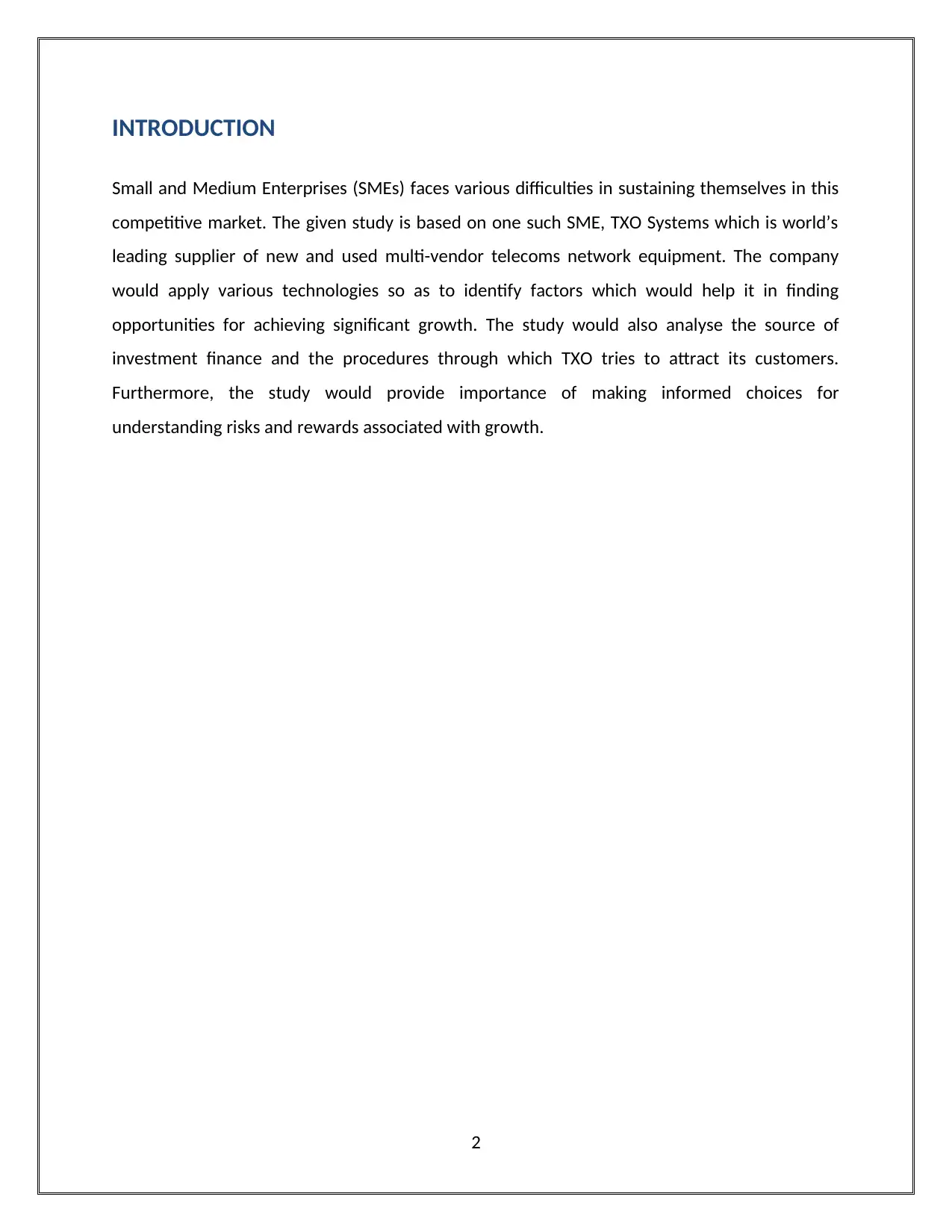
INTRODUCTION
Small and Medium Enterprises (SMEs) faces various difficulties in sustaining themselves in this
competitive market. The given study is based on one such SME, TXO Systems which is world’s
leading supplier of new and used multi-vendor telecoms network equipment. The company
would apply various technologies so as to identify factors which would help it in finding
opportunities for achieving significant growth. The study would also analyse the source of
investment finance and the procedures through which TXO tries to attract its customers.
Furthermore, the study would provide importance of making informed choices for
understanding risks and rewards associated with growth.
2
Small and Medium Enterprises (SMEs) faces various difficulties in sustaining themselves in this
competitive market. The given study is based on one such SME, TXO Systems which is world’s
leading supplier of new and used multi-vendor telecoms network equipment. The company
would apply various technologies so as to identify factors which would help it in finding
opportunities for achieving significant growth. The study would also analyse the source of
investment finance and the procedures through which TXO tries to attract its customers.
Furthermore, the study would provide importance of making informed choices for
understanding risks and rewards associated with growth.
2
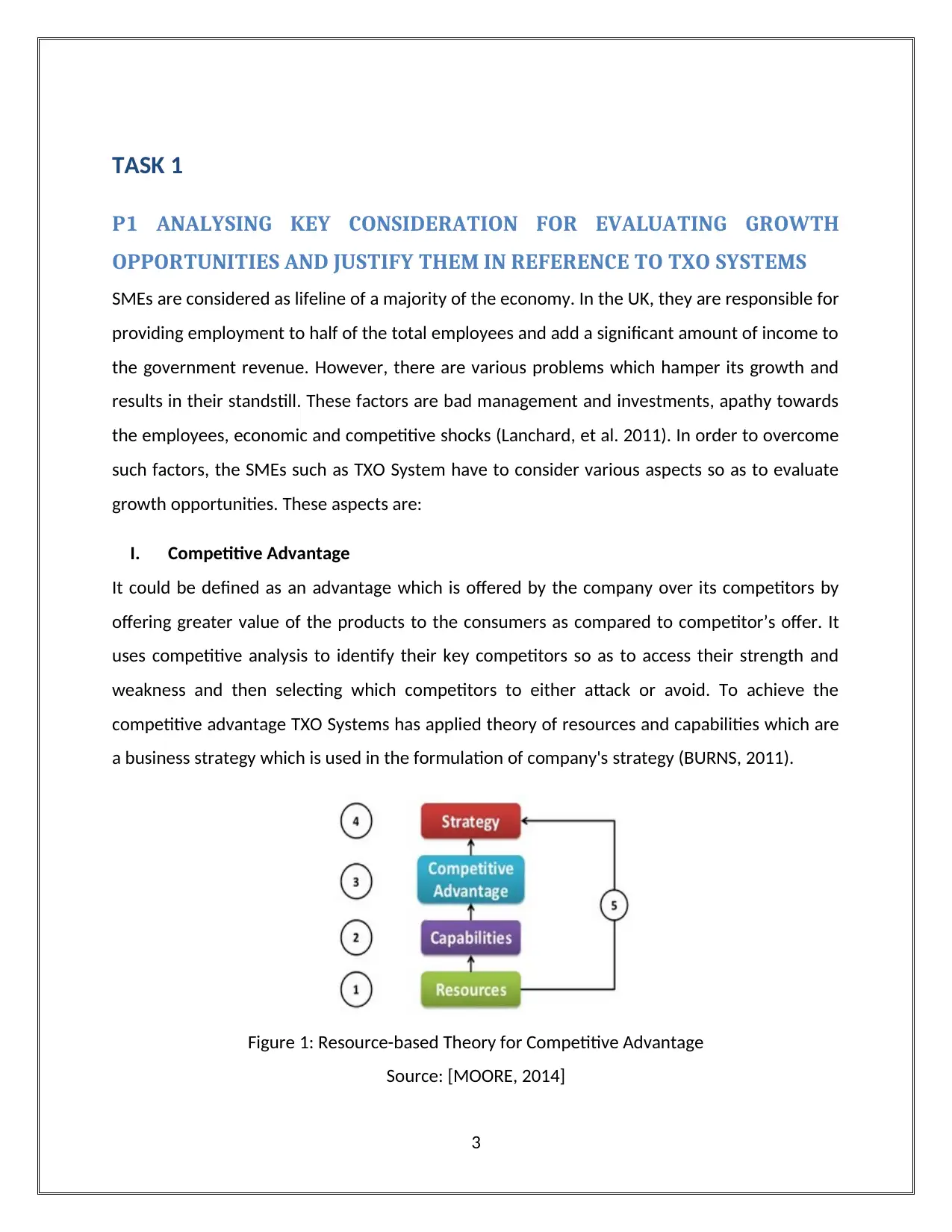
TASK 1
P1 ANALYSING KEY CONSIDERATION FOR EVALUATING GROWTH
OPPORTUNITIES AND JUSTIFY THEM IN REFERENCE TO TXO SYSTEMS
SMEs are considered as lifeline of a majority of the economy. In the UK, they are responsible for
providing employment to half of the total employees and add a significant amount of income to
the government revenue. However, there are various problems which hamper its growth and
results in their standstill. These factors are bad management and investments, apathy towards
the employees, economic and competitive shocks (Lanchard, et al. 2011). In order to overcome
such factors, the SMEs such as TXO System have to consider various aspects so as to evaluate
growth opportunities. These aspects are:
I. Competitive Advantage
It could be defined as an advantage which is offered by the company over its competitors by
offering greater value of the products to the consumers as compared to competitor’s offer. It
uses competitive analysis to identify their key competitors so as to access their strength and
weakness and then selecting which competitors to either attack or avoid. To achieve the
competitive advantage TXO Systems has applied theory of resources and capabilities which are
a business strategy which is used in the formulation of company's strategy (BURNS, 2011).
Figure 1: Resource-based Theory for Competitive Advantage
Source: [MOORE, 2014]
3
P1 ANALYSING KEY CONSIDERATION FOR EVALUATING GROWTH
OPPORTUNITIES AND JUSTIFY THEM IN REFERENCE TO TXO SYSTEMS
SMEs are considered as lifeline of a majority of the economy. In the UK, they are responsible for
providing employment to half of the total employees and add a significant amount of income to
the government revenue. However, there are various problems which hamper its growth and
results in their standstill. These factors are bad management and investments, apathy towards
the employees, economic and competitive shocks (Lanchard, et al. 2011). In order to overcome
such factors, the SMEs such as TXO System have to consider various aspects so as to evaluate
growth opportunities. These aspects are:
I. Competitive Advantage
It could be defined as an advantage which is offered by the company over its competitors by
offering greater value of the products to the consumers as compared to competitor’s offer. It
uses competitive analysis to identify their key competitors so as to access their strength and
weakness and then selecting which competitors to either attack or avoid. To achieve the
competitive advantage TXO Systems has applied theory of resources and capabilities which are
a business strategy which is used in the formulation of company's strategy (BURNS, 2011).
Figure 1: Resource-based Theory for Competitive Advantage
Source: [MOORE, 2014]
3
Secure Best Marks with AI Grader
Need help grading? Try our AI Grader for instant feedback on your assignments.
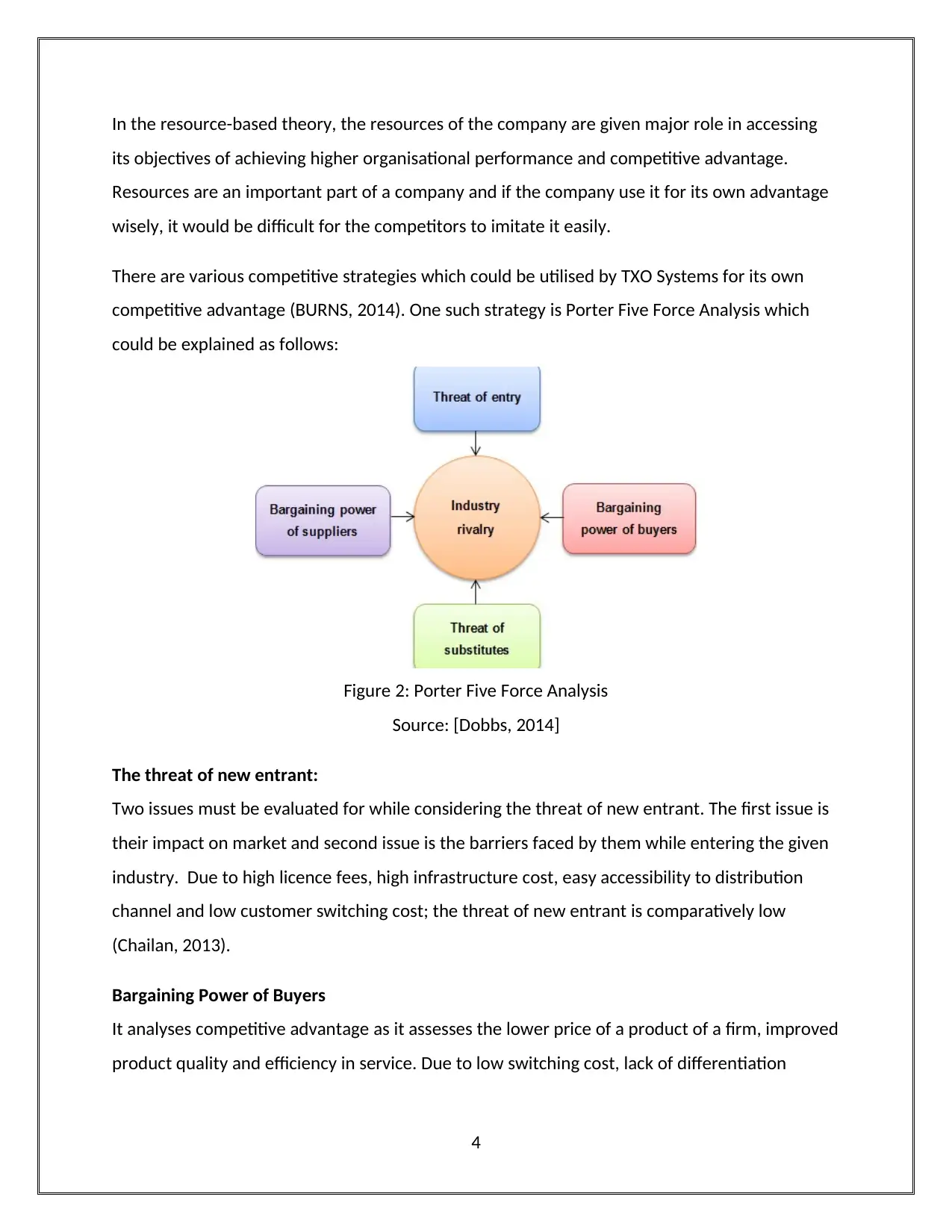
In the resource-based theory, the resources of the company are given major role in accessing
its objectives of achieving higher organisational performance and competitive advantage.
Resources are an important part of a company and if the company use it for its own advantage
wisely, it would be difficult for the competitors to imitate it easily.
There are various competitive strategies which could be utilised by TXO Systems for its own
competitive advantage (BURNS, 2014). One such strategy is Porter Five Force Analysis which
could be explained as follows:
Figure 2: Porter Five Force Analysis
Source: [Dobbs, 2014]
The threat of new entrant:
Two issues must be evaluated for while considering the threat of new entrant. The first issue is
their impact on market and second issue is the barriers faced by them while entering the given
industry. Due to high licence fees, high infrastructure cost, easy accessibility to distribution
channel and low customer switching cost; the threat of new entrant is comparatively low
(Chailan, 2013).
Bargaining Power of Buyers
It analyses competitive advantage as it assesses the lower price of a product of a firm, improved
product quality and efficiency in service. Due to low switching cost, lack of differentiation
4
its objectives of achieving higher organisational performance and competitive advantage.
Resources are an important part of a company and if the company use it for its own advantage
wisely, it would be difficult for the competitors to imitate it easily.
There are various competitive strategies which could be utilised by TXO Systems for its own
competitive advantage (BURNS, 2014). One such strategy is Porter Five Force Analysis which
could be explained as follows:
Figure 2: Porter Five Force Analysis
Source: [Dobbs, 2014]
The threat of new entrant:
Two issues must be evaluated for while considering the threat of new entrant. The first issue is
their impact on market and second issue is the barriers faced by them while entering the given
industry. Due to high licence fees, high infrastructure cost, easy accessibility to distribution
channel and low customer switching cost; the threat of new entrant is comparatively low
(Chailan, 2013).
Bargaining Power of Buyers
It analyses competitive advantage as it assesses the lower price of a product of a firm, improved
product quality and efficiency in service. Due to low switching cost, lack of differentiation
4
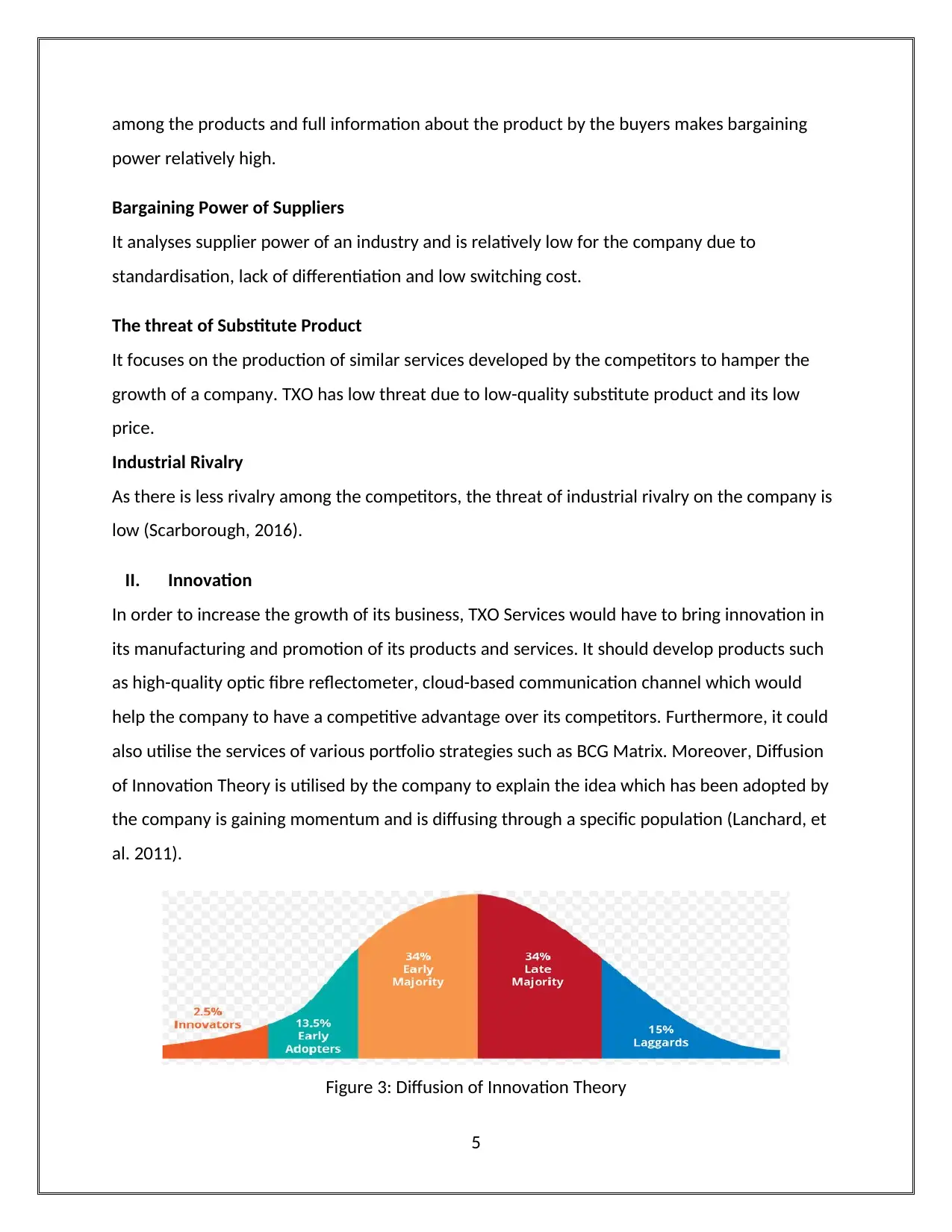
among the products and full information about the product by the buyers makes bargaining
power relatively high.
Bargaining Power of Suppliers
It analyses supplier power of an industry and is relatively low for the company due to
standardisation, lack of differentiation and low switching cost.
The threat of Substitute Product
It focuses on the production of similar services developed by the competitors to hamper the
growth of a company. TXO has low threat due to low-quality substitute product and its low
price.
Industrial Rivalry
As there is less rivalry among the competitors, the threat of industrial rivalry on the company is
low (Scarborough, 2016).
II. Innovation
In order to increase the growth of its business, TXO Services would have to bring innovation in
its manufacturing and promotion of its products and services. It should develop products such
as high-quality optic fibre reflectometer, cloud-based communication channel which would
help the company to have a competitive advantage over its competitors. Furthermore, it could
also utilise the services of various portfolio strategies such as BCG Matrix. Moreover, Diffusion
of Innovation Theory is utilised by the company to explain the idea which has been adopted by
the company is gaining momentum and is diffusing through a specific population (Lanchard, et
al. 2011).
Figure 3: Diffusion of Innovation Theory
5
power relatively high.
Bargaining Power of Suppliers
It analyses supplier power of an industry and is relatively low for the company due to
standardisation, lack of differentiation and low switching cost.
The threat of Substitute Product
It focuses on the production of similar services developed by the competitors to hamper the
growth of a company. TXO has low threat due to low-quality substitute product and its low
price.
Industrial Rivalry
As there is less rivalry among the competitors, the threat of industrial rivalry on the company is
low (Scarborough, 2016).
II. Innovation
In order to increase the growth of its business, TXO Services would have to bring innovation in
its manufacturing and promotion of its products and services. It should develop products such
as high-quality optic fibre reflectometer, cloud-based communication channel which would
help the company to have a competitive advantage over its competitors. Furthermore, it could
also utilise the services of various portfolio strategies such as BCG Matrix. Moreover, Diffusion
of Innovation Theory is utilised by the company to explain the idea which has been adopted by
the company is gaining momentum and is diffusing through a specific population (Lanchard, et
al. 2011).
Figure 3: Diffusion of Innovation Theory
5
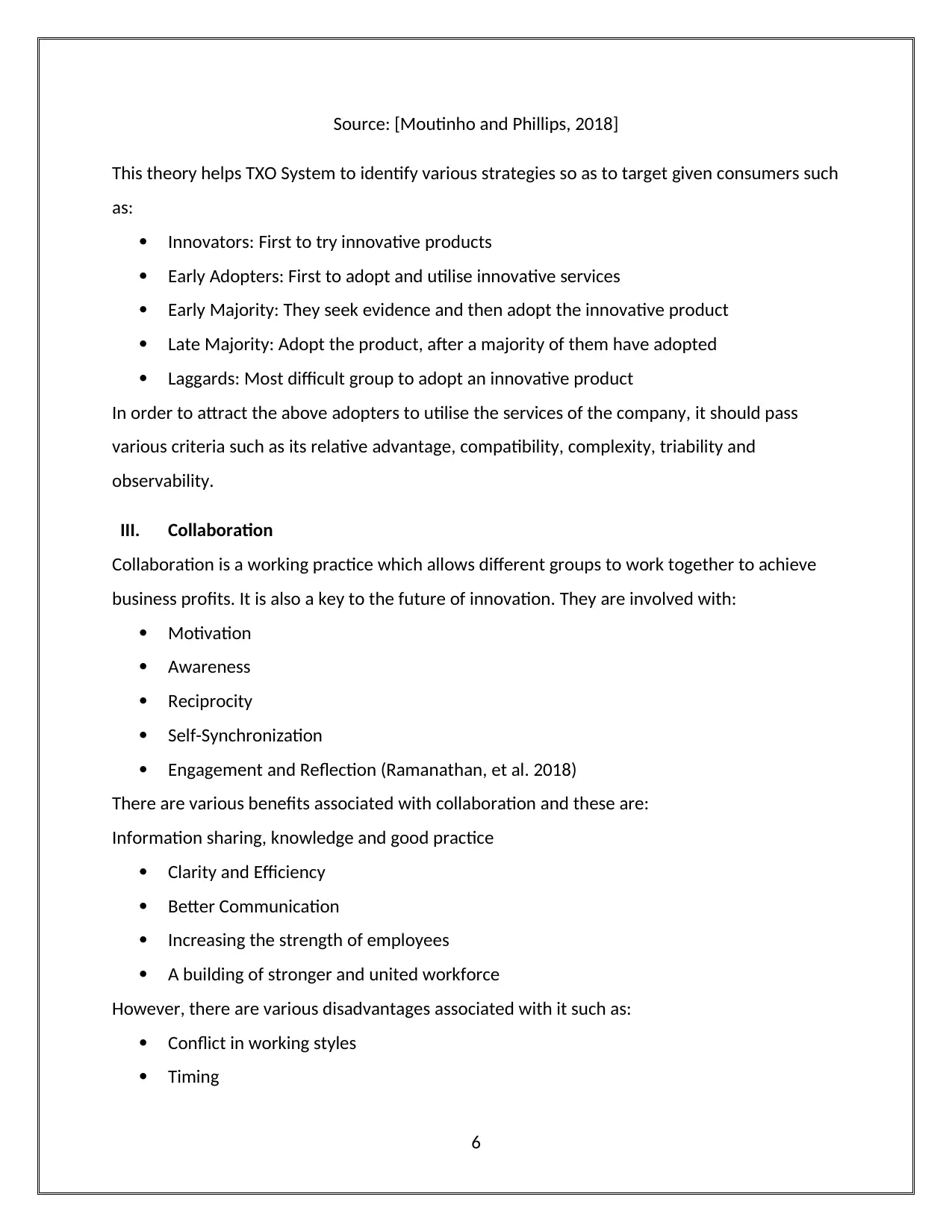
Source: [Moutinho and Phillips, 2018]
This theory helps TXO System to identify various strategies so as to target given consumers such
as:
Innovators: First to try innovative products
Early Adopters: First to adopt and utilise innovative services
Early Majority: They seek evidence and then adopt the innovative product
Late Majority: Adopt the product, after a majority of them have adopted
Laggards: Most difficult group to adopt an innovative product
In order to attract the above adopters to utilise the services of the company, it should pass
various criteria such as its relative advantage, compatibility, complexity, triability and
observability.
III. Collaboration
Collaboration is a working practice which allows different groups to work together to achieve
business profits. It is also a key to the future of innovation. They are involved with:
Motivation
Awareness
Reciprocity
Self-Synchronization
Engagement and Reflection (Ramanathan, et al. 2018)
There are various benefits associated with collaboration and these are:
Information sharing, knowledge and good practice
Clarity and Efficiency
Better Communication
Increasing the strength of employees
A building of stronger and united workforce
However, there are various disadvantages associated with it such as:
Conflict in working styles
Timing
6
This theory helps TXO System to identify various strategies so as to target given consumers such
as:
Innovators: First to try innovative products
Early Adopters: First to adopt and utilise innovative services
Early Majority: They seek evidence and then adopt the innovative product
Late Majority: Adopt the product, after a majority of them have adopted
Laggards: Most difficult group to adopt an innovative product
In order to attract the above adopters to utilise the services of the company, it should pass
various criteria such as its relative advantage, compatibility, complexity, triability and
observability.
III. Collaboration
Collaboration is a working practice which allows different groups to work together to achieve
business profits. It is also a key to the future of innovation. They are involved with:
Motivation
Awareness
Reciprocity
Self-Synchronization
Engagement and Reflection (Ramanathan, et al. 2018)
There are various benefits associated with collaboration and these are:
Information sharing, knowledge and good practice
Clarity and Efficiency
Better Communication
Increasing the strength of employees
A building of stronger and united workforce
However, there are various disadvantages associated with it such as:
Conflict in working styles
Timing
6
Paraphrase This Document
Need a fresh take? Get an instant paraphrase of this document with our AI Paraphraser
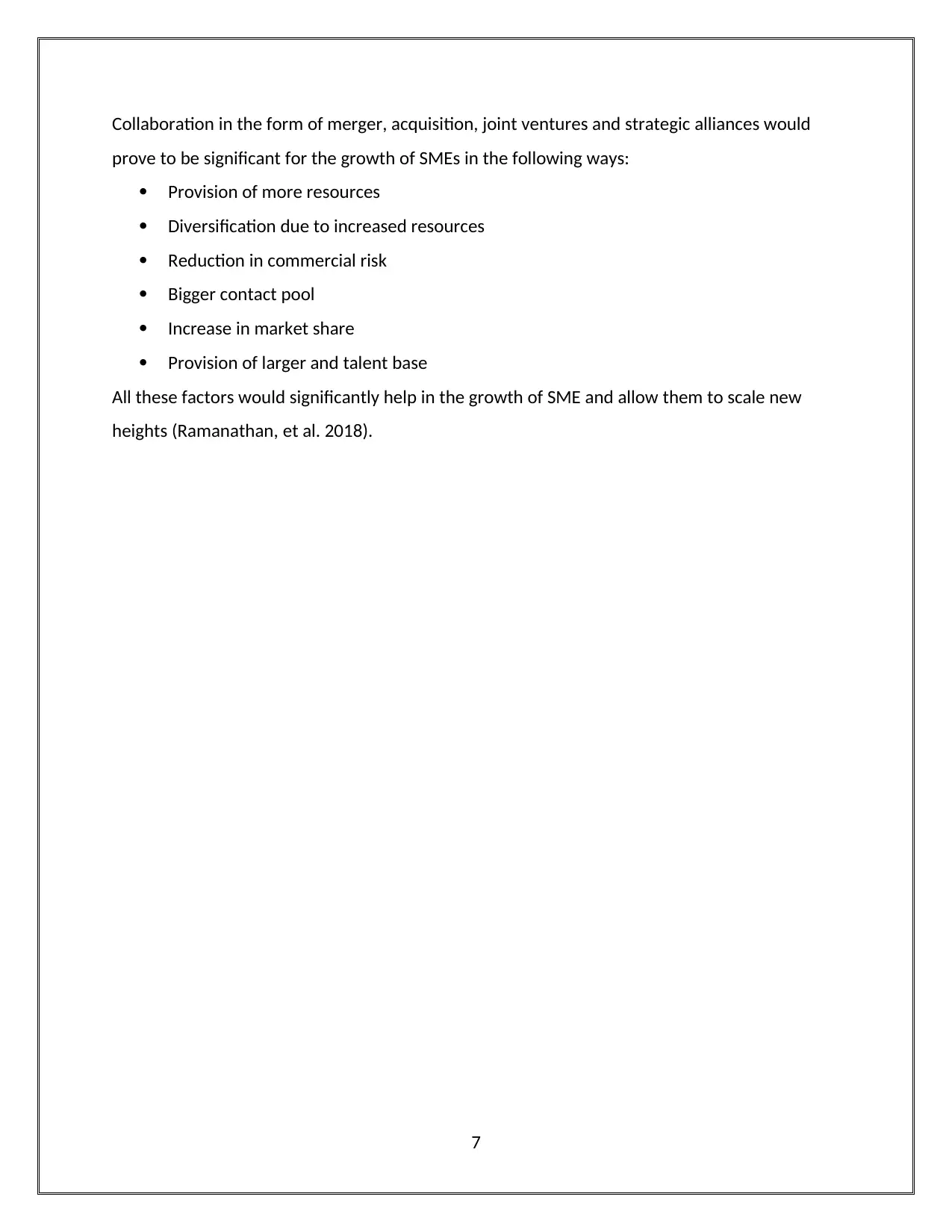
Collaboration in the form of merger, acquisition, joint ventures and strategic alliances would
prove to be significant for the growth of SMEs in the following ways:
Provision of more resources
Diversification due to increased resources
Reduction in commercial risk
Bigger contact pool
Increase in market share
Provision of larger and talent base
All these factors would significantly help in the growth of SME and allow them to scale new
heights (Ramanathan, et al. 2018).
7
prove to be significant for the growth of SMEs in the following ways:
Provision of more resources
Diversification due to increased resources
Reduction in commercial risk
Bigger contact pool
Increase in market share
Provision of larger and talent base
All these factors would significantly help in the growth of SME and allow them to scale new
heights (Ramanathan, et al. 2018).
7
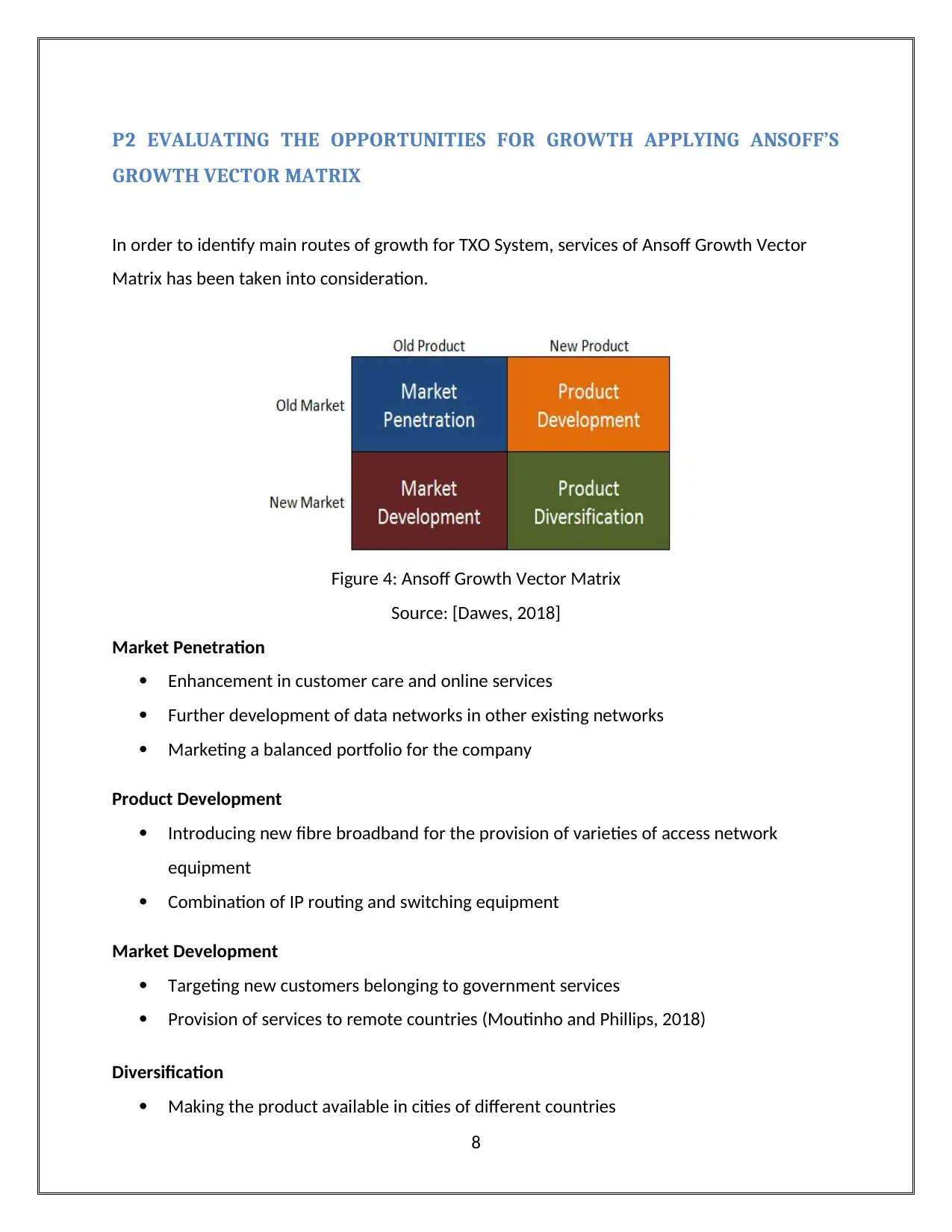
P2 EVALUATING THE OPPORTUNITIES FOR GROWTH APPLYING ANSOFF’S
GROWTH VECTOR MATRIX
In order to identify main routes of growth for TXO System, services of Ansoff Growth Vector
Matrix has been taken into consideration.
Figure 4: Ansoff Growth Vector Matrix
Source: [Dawes, 2018]
Market Penetration
Enhancement in customer care and online services
Further development of data networks in other existing networks
Marketing a balanced portfolio for the company
Product Development
Introducing new fibre broadband for the provision of varieties of access network
equipment
Combination of IP routing and switching equipment
Market Development
Targeting new customers belonging to government services
Provision of services to remote countries (Moutinho and Phillips, 2018)
Diversification
Making the product available in cities of different countries
8
GROWTH VECTOR MATRIX
In order to identify main routes of growth for TXO System, services of Ansoff Growth Vector
Matrix has been taken into consideration.
Figure 4: Ansoff Growth Vector Matrix
Source: [Dawes, 2018]
Market Penetration
Enhancement in customer care and online services
Further development of data networks in other existing networks
Marketing a balanced portfolio for the company
Product Development
Introducing new fibre broadband for the provision of varieties of access network
equipment
Combination of IP routing and switching equipment
Market Development
Targeting new customers belonging to government services
Provision of services to remote countries (Moutinho and Phillips, 2018)
Diversification
Making the product available in cities of different countries
8
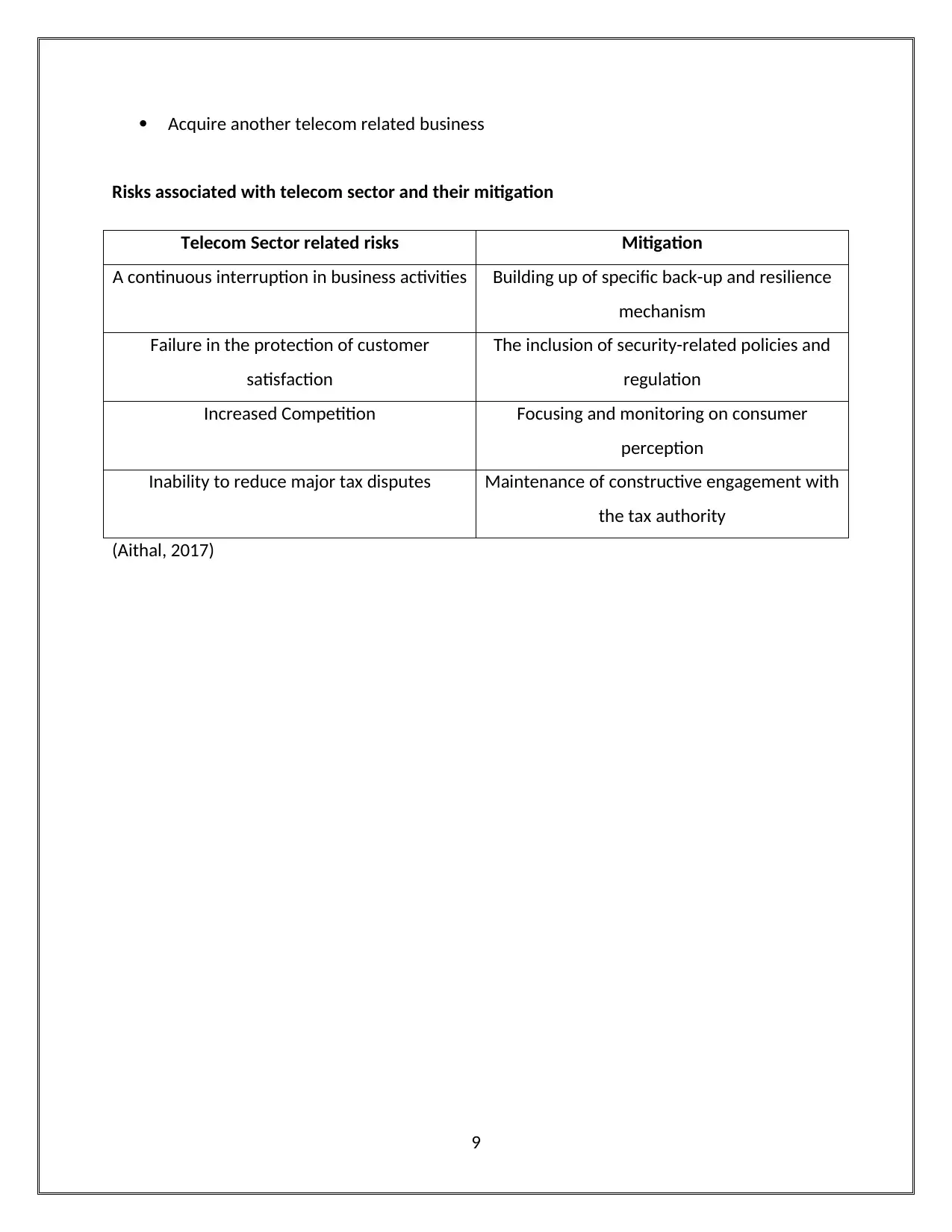
Acquire another telecom related business
Risks associated with telecom sector and their mitigation
Telecom Sector related risks Mitigation
A continuous interruption in business activities Building up of specific back-up and resilience
mechanism
Failure in the protection of customer
satisfaction
The inclusion of security-related policies and
regulation
Increased Competition Focusing and monitoring on consumer
perception
Inability to reduce major tax disputes Maintenance of constructive engagement with
the tax authority
(Aithal, 2017)
9
Risks associated with telecom sector and their mitigation
Telecom Sector related risks Mitigation
A continuous interruption in business activities Building up of specific back-up and resilience
mechanism
Failure in the protection of customer
satisfaction
The inclusion of security-related policies and
regulation
Increased Competition Focusing and monitoring on consumer
perception
Inability to reduce major tax disputes Maintenance of constructive engagement with
the tax authority
(Aithal, 2017)
9
Secure Best Marks with AI Grader
Need help grading? Try our AI Grader for instant feedback on your assignments.
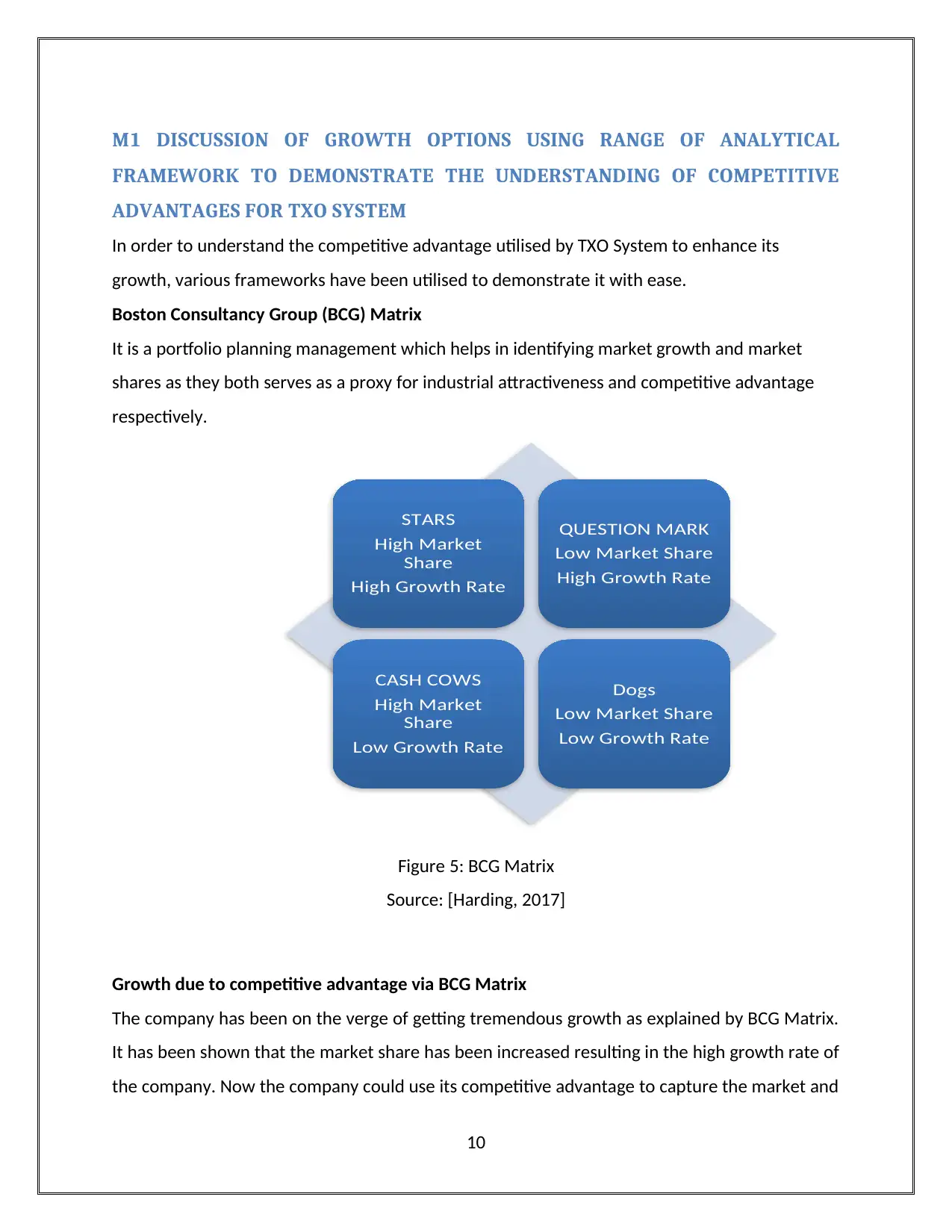
M1 DISCUSSION OF GROWTH OPTIONS USING RANGE OF ANALYTICAL
FRAMEWORK TO DEMONSTRATE THE UNDERSTANDING OF COMPETITIVE
ADVANTAGES FOR TXO SYSTEM
In order to understand the competitive advantage utilised by TXO System to enhance its
growth, various frameworks have been utilised to demonstrate it with ease.
Boston Consultancy Group (BCG) Matrix
It is a portfolio planning management which helps in identifying market growth and market
shares as they both serves as a proxy for industrial attractiveness and competitive advantage
respectively.
Figure 5: BCG Matrix
Source: [Harding, 2017]
Growth due to competitive advantage via BCG Matrix
The company has been on the verge of getting tremendous growth as explained by BCG Matrix.
It has been shown that the market share has been increased resulting in the high growth rate of
the company. Now the company could use its competitive advantage to capture the market and
10
STARS
High Market
Share
High Growth Rate
QUESTION MARK
Low Market Share
High Growth Rate
CASH COWS
High Market
Share
Low Growth Rate
Dogs
Low Market Share
Low Growth Rate
FRAMEWORK TO DEMONSTRATE THE UNDERSTANDING OF COMPETITIVE
ADVANTAGES FOR TXO SYSTEM
In order to understand the competitive advantage utilised by TXO System to enhance its
growth, various frameworks have been utilised to demonstrate it with ease.
Boston Consultancy Group (BCG) Matrix
It is a portfolio planning management which helps in identifying market growth and market
shares as they both serves as a proxy for industrial attractiveness and competitive advantage
respectively.
Figure 5: BCG Matrix
Source: [Harding, 2017]
Growth due to competitive advantage via BCG Matrix
The company has been on the verge of getting tremendous growth as explained by BCG Matrix.
It has been shown that the market share has been increased resulting in the high growth rate of
the company. Now the company could use its competitive advantage to capture the market and
10
STARS
High Market
Share
High Growth Rate
QUESTION MARK
Low Market Share
High Growth Rate
CASH COWS
High Market
Share
Low Growth Rate
Dogs
Low Market Share
Low Growth Rate
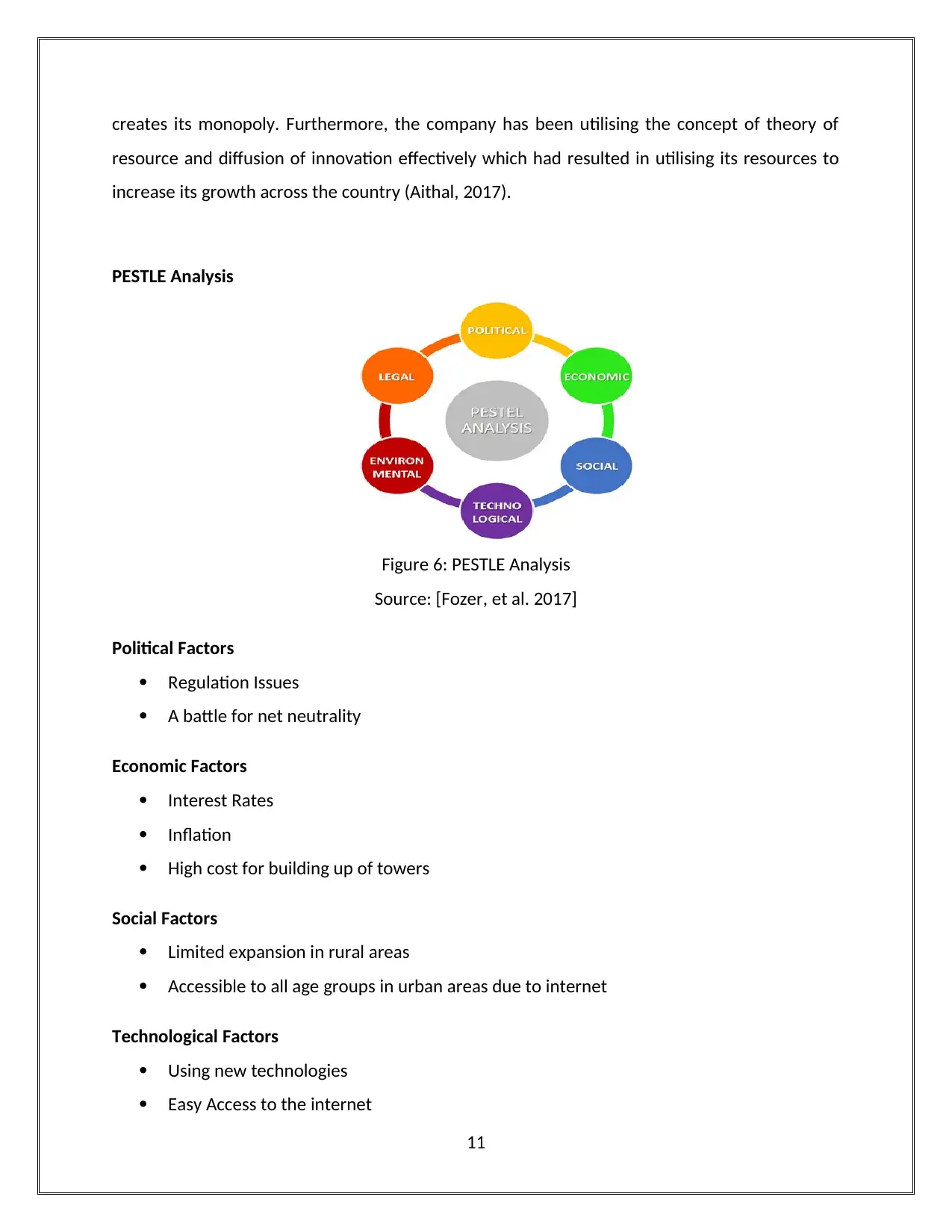
creates its monopoly. Furthermore, the company has been utilising the concept of theory of
resource and diffusion of innovation effectively which had resulted in utilising its resources to
increase its growth across the country (Aithal, 2017).
PESTLE Analysis
Figure 6: PESTLE Analysis
Source: [Fozer, et al. 2017]
Political Factors
Regulation Issues
A battle for net neutrality
Economic Factors
Interest Rates
Inflation
High cost for building up of towers
Social Factors
Limited expansion in rural areas
Accessible to all age groups in urban areas due to internet
Technological Factors
Using new technologies
Easy Access to the internet
11
resource and diffusion of innovation effectively which had resulted in utilising its resources to
increase its growth across the country (Aithal, 2017).
PESTLE Analysis
Figure 6: PESTLE Analysis
Source: [Fozer, et al. 2017]
Political Factors
Regulation Issues
A battle for net neutrality
Economic Factors
Interest Rates
Inflation
High cost for building up of towers
Social Factors
Limited expansion in rural areas
Accessible to all age groups in urban areas due to internet
Technological Factors
Using new technologies
Easy Access to the internet
11
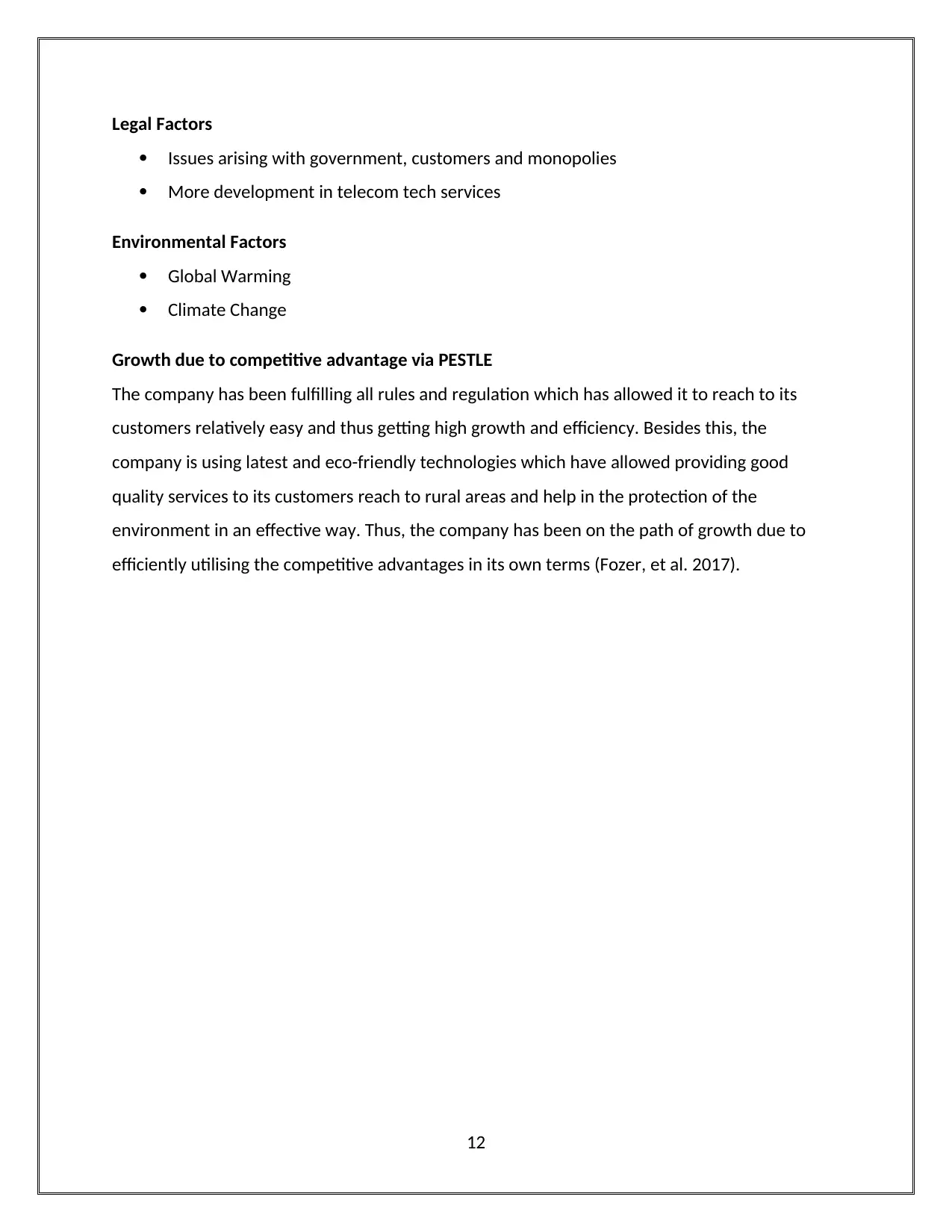
Legal Factors
Issues arising with government, customers and monopolies
More development in telecom tech services
Environmental Factors
Global Warming
Climate Change
Growth due to competitive advantage via PESTLE
The company has been fulfilling all rules and regulation which has allowed it to reach to its
customers relatively easy and thus getting high growth and efficiency. Besides this, the
company is using latest and eco-friendly technologies which have allowed providing good
quality services to its customers reach to rural areas and help in the protection of the
environment in an effective way. Thus, the company has been on the path of growth due to
efficiently utilising the competitive advantages in its own terms (Fozer, et al. 2017).
12
Issues arising with government, customers and monopolies
More development in telecom tech services
Environmental Factors
Global Warming
Climate Change
Growth due to competitive advantage via PESTLE
The company has been fulfilling all rules and regulation which has allowed it to reach to its
customers relatively easy and thus getting high growth and efficiency. Besides this, the
company is using latest and eco-friendly technologies which have allowed providing good
quality services to its customers reach to rural areas and help in the protection of the
environment in an effective way. Thus, the company has been on the path of growth due to
efficiently utilising the competitive advantages in its own terms (Fozer, et al. 2017).
12
Paraphrase This Document
Need a fresh take? Get an instant paraphrase of this document with our AI Paraphraser
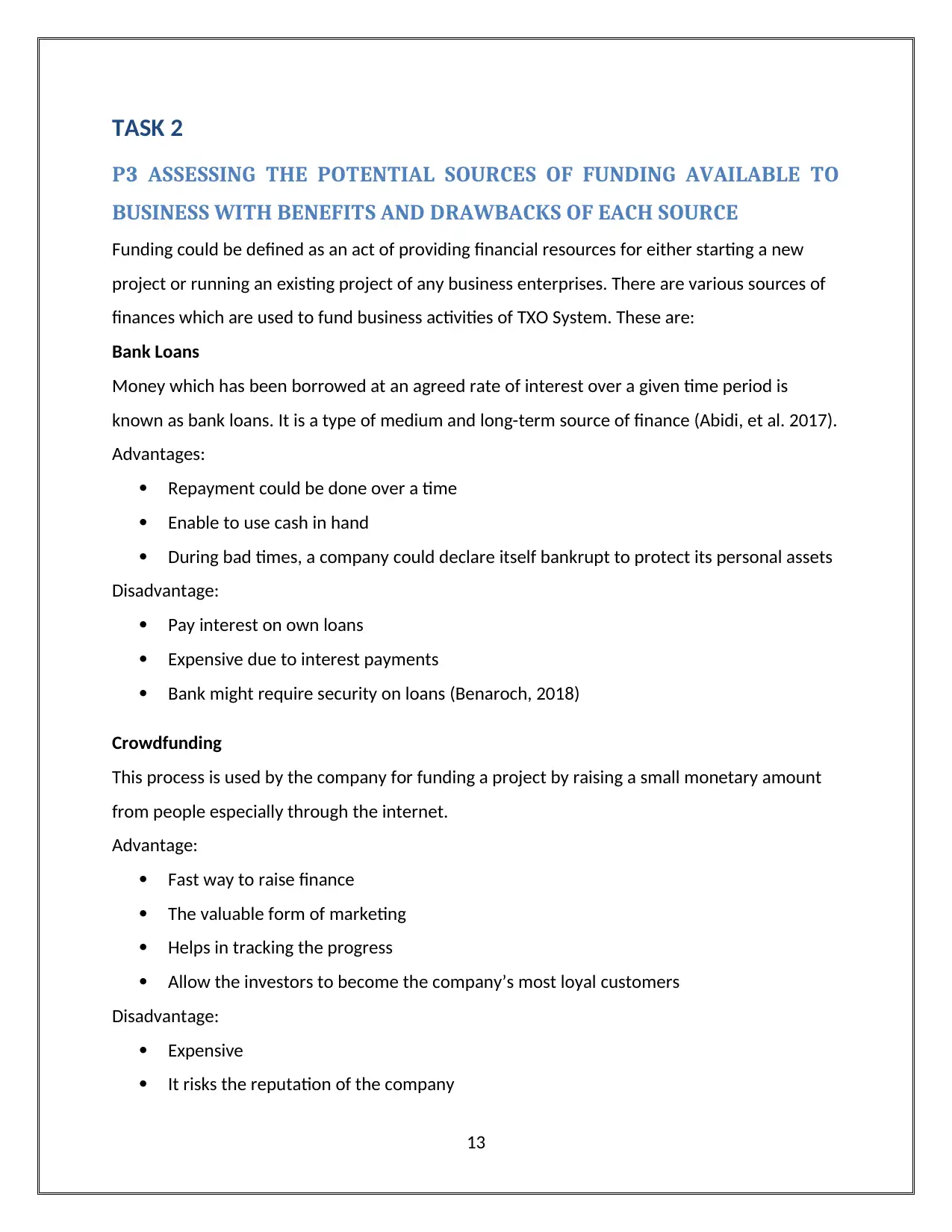
TASK 2
P3 ASSESSING THE POTENTIAL SOURCES OF FUNDING AVAILABLE TO
BUSINESS WITH BENEFITS AND DRAWBACKS OF EACH SOURCE
Funding could be defined as an act of providing financial resources for either starting a new
project or running an existing project of any business enterprises. There are various sources of
finances which are used to fund business activities of TXO System. These are:
Bank Loans
Money which has been borrowed at an agreed rate of interest over a given time period is
known as bank loans. It is a type of medium and long-term source of finance (Abidi, et al. 2017).
Advantages:
Repayment could be done over a time
Enable to use cash in hand
During bad times, a company could declare itself bankrupt to protect its personal assets
Disadvantage:
Pay interest on own loans
Expensive due to interest payments
Bank might require security on loans (Benaroch, 2018)
Crowdfunding
This process is used by the company for funding a project by raising a small monetary amount
from people especially through the internet.
Advantage:
Fast way to raise finance
The valuable form of marketing
Helps in tracking the progress
Allow the investors to become the company’s most loyal customers
Disadvantage:
Expensive
It risks the reputation of the company
13
P3 ASSESSING THE POTENTIAL SOURCES OF FUNDING AVAILABLE TO
BUSINESS WITH BENEFITS AND DRAWBACKS OF EACH SOURCE
Funding could be defined as an act of providing financial resources for either starting a new
project or running an existing project of any business enterprises. There are various sources of
finances which are used to fund business activities of TXO System. These are:
Bank Loans
Money which has been borrowed at an agreed rate of interest over a given time period is
known as bank loans. It is a type of medium and long-term source of finance (Abidi, et al. 2017).
Advantages:
Repayment could be done over a time
Enable to use cash in hand
During bad times, a company could declare itself bankrupt to protect its personal assets
Disadvantage:
Pay interest on own loans
Expensive due to interest payments
Bank might require security on loans (Benaroch, 2018)
Crowdfunding
This process is used by the company for funding a project by raising a small monetary amount
from people especially through the internet.
Advantage:
Fast way to raise finance
The valuable form of marketing
Helps in tracking the progress
Allow the investors to become the company’s most loyal customers
Disadvantage:
Expensive
It risks the reputation of the company
13
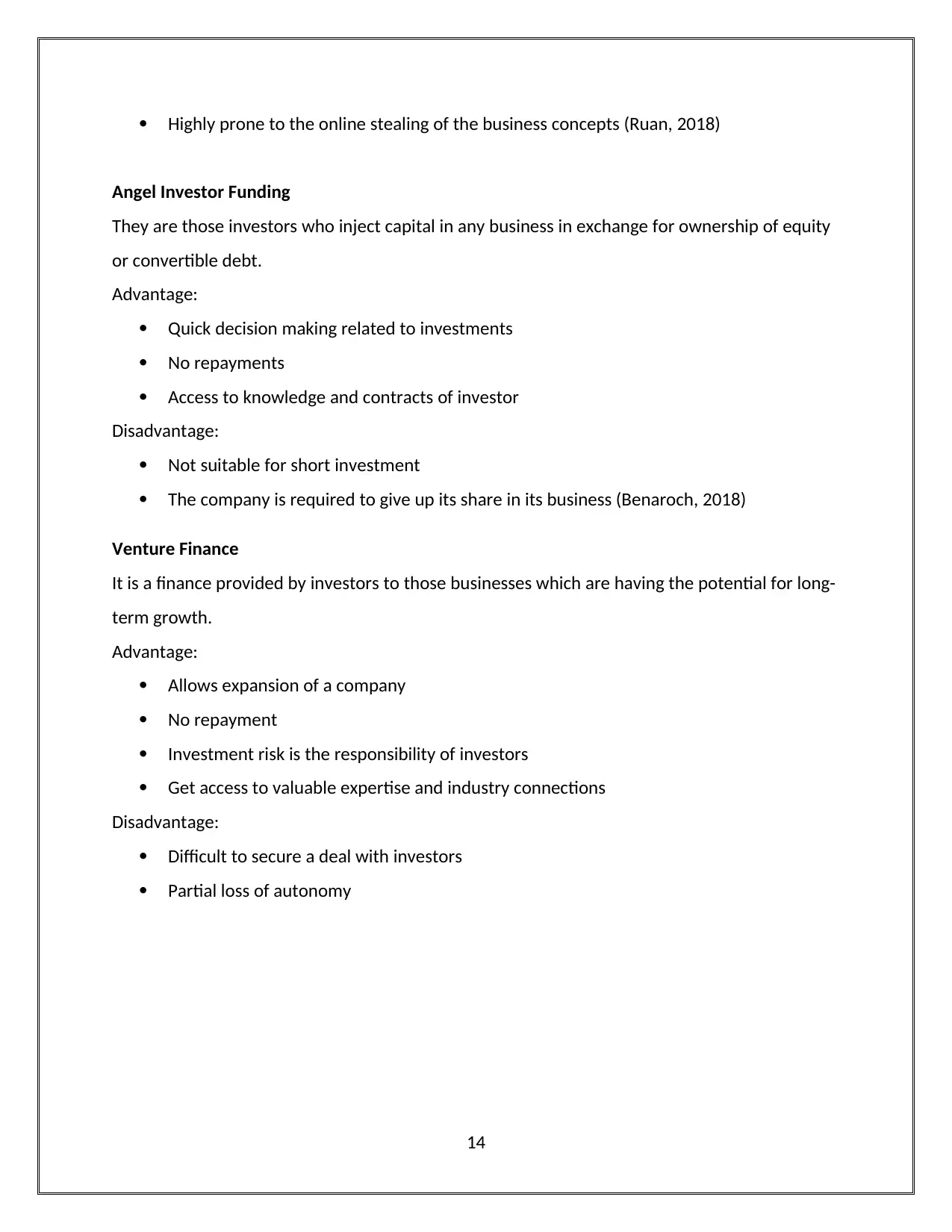
Highly prone to the online stealing of the business concepts (Ruan, 2018)
Angel Investor Funding
They are those investors who inject capital in any business in exchange for ownership of equity
or convertible debt.
Advantage:
Quick decision making related to investments
No repayments
Access to knowledge and contracts of investor
Disadvantage:
Not suitable for short investment
The company is required to give up its share in its business (Benaroch, 2018)
Venture Finance
It is a finance provided by investors to those businesses which are having the potential for long-
term growth.
Advantage:
Allows expansion of a company
No repayment
Investment risk is the responsibility of investors
Get access to valuable expertise and industry connections
Disadvantage:
Difficult to secure a deal with investors
Partial loss of autonomy
14
Angel Investor Funding
They are those investors who inject capital in any business in exchange for ownership of equity
or convertible debt.
Advantage:
Quick decision making related to investments
No repayments
Access to knowledge and contracts of investor
Disadvantage:
Not suitable for short investment
The company is required to give up its share in its business (Benaroch, 2018)
Venture Finance
It is a finance provided by investors to those businesses which are having the potential for long-
term growth.
Advantage:
Allows expansion of a company
No repayment
Investment risk is the responsibility of investors
Get access to valuable expertise and industry connections
Disadvantage:
Difficult to secure a deal with investors
Partial loss of autonomy
14
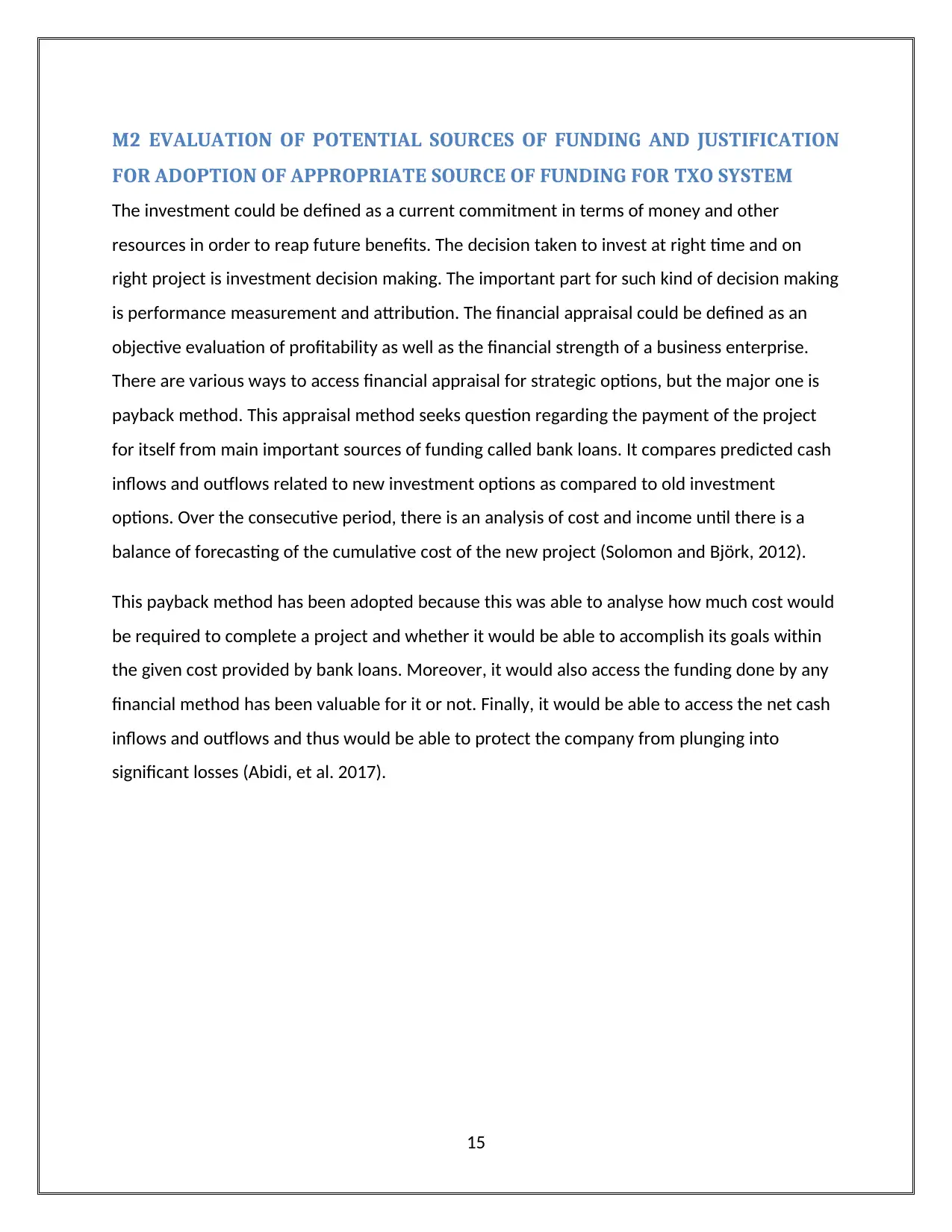
M2 EVALUATION OF POTENTIAL SOURCES OF FUNDING AND JUSTIFICATION
FOR ADOPTION OF APPROPRIATE SOURCE OF FUNDING FOR TXO SYSTEM
The investment could be defined as a current commitment in terms of money and other
resources in order to reap future benefits. The decision taken to invest at right time and on
right project is investment decision making. The important part for such kind of decision making
is performance measurement and attribution. The financial appraisal could be defined as an
objective evaluation of profitability as well as the financial strength of a business enterprise.
There are various ways to access financial appraisal for strategic options, but the major one is
payback method. This appraisal method seeks question regarding the payment of the project
for itself from main important sources of funding called bank loans. It compares predicted cash
inflows and outflows related to new investment options as compared to old investment
options. Over the consecutive period, there is an analysis of cost and income until there is a
balance of forecasting of the cumulative cost of the new project (Solomon and Björk, 2012).
This payback method has been adopted because this was able to analyse how much cost would
be required to complete a project and whether it would be able to accomplish its goals within
the given cost provided by bank loans. Moreover, it would also access the funding done by any
financial method has been valuable for it or not. Finally, it would be able to access the net cash
inflows and outflows and thus would be able to protect the company from plunging into
significant losses (Abidi, et al. 2017).
15
FOR ADOPTION OF APPROPRIATE SOURCE OF FUNDING FOR TXO SYSTEM
The investment could be defined as a current commitment in terms of money and other
resources in order to reap future benefits. The decision taken to invest at right time and on
right project is investment decision making. The important part for such kind of decision making
is performance measurement and attribution. The financial appraisal could be defined as an
objective evaluation of profitability as well as the financial strength of a business enterprise.
There are various ways to access financial appraisal for strategic options, but the major one is
payback method. This appraisal method seeks question regarding the payment of the project
for itself from main important sources of funding called bank loans. It compares predicted cash
inflows and outflows related to new investment options as compared to old investment
options. Over the consecutive period, there is an analysis of cost and income until there is a
balance of forecasting of the cumulative cost of the new project (Solomon and Björk, 2012).
This payback method has been adopted because this was able to analyse how much cost would
be required to complete a project and whether it would be able to accomplish its goals within
the given cost provided by bank loans. Moreover, it would also access the funding done by any
financial method has been valuable for it or not. Finally, it would be able to access the net cash
inflows and outflows and thus would be able to protect the company from plunging into
significant losses (Abidi, et al. 2017).
15
Secure Best Marks with AI Grader
Need help grading? Try our AI Grader for instant feedback on your assignments.
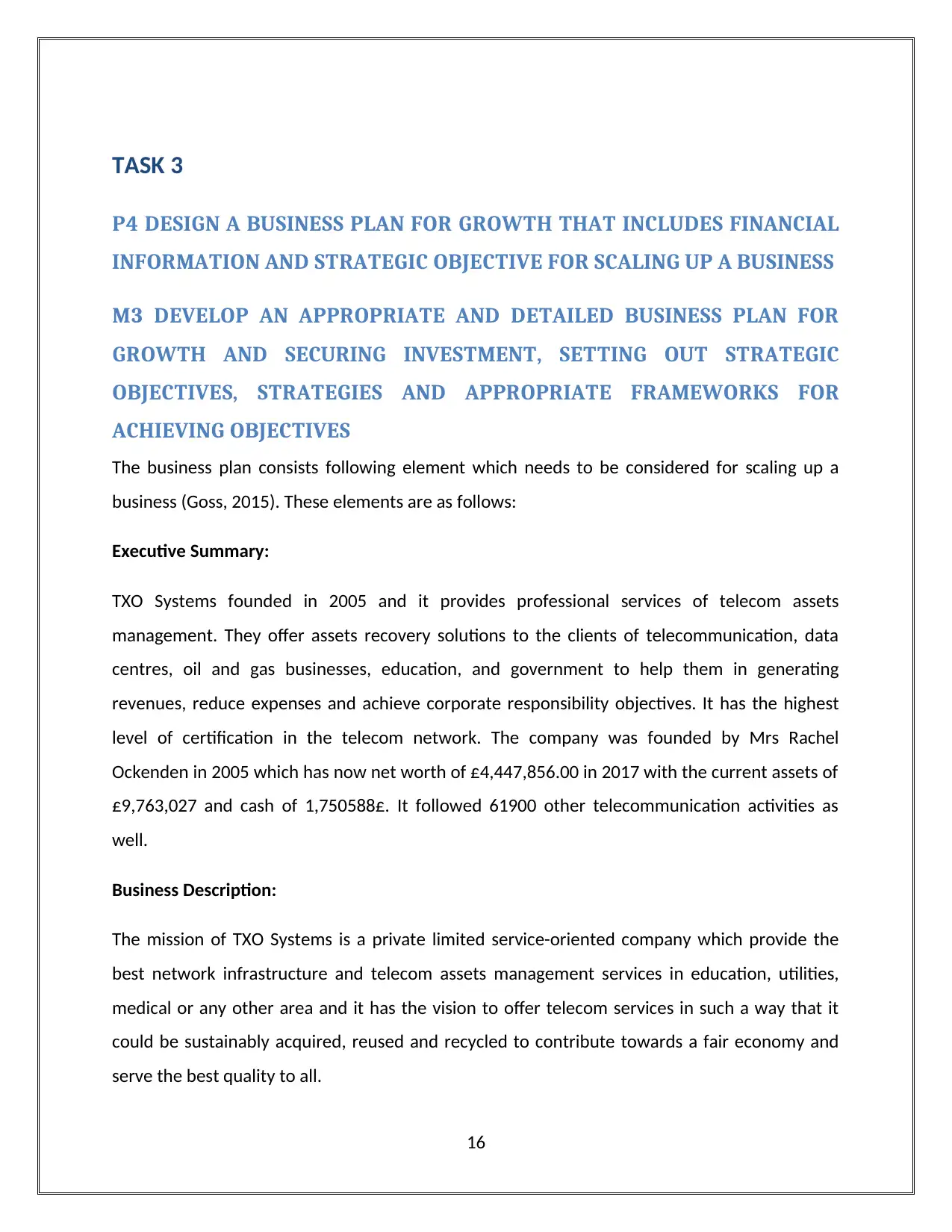
TASK 3
P4 DESIGN A BUSINESS PLAN FOR GROWTH THAT INCLUDES FINANCIAL
INFORMATION AND STRATEGIC OBJECTIVE FOR SCALING UP A BUSINESS
M3 DEVELOP AN APPROPRIATE AND DETAILED BUSINESS PLAN FOR
GROWTH AND SECURING INVESTMENT, SETTING OUT STRATEGIC
OBJECTIVES, STRATEGIES AND APPROPRIATE FRAMEWORKS FOR
ACHIEVING OBJECTIVES
The business plan consists following element which needs to be considered for scaling up a
business (Goss, 2015). These elements are as follows:
Executive Summary:
TXO Systems founded in 2005 and it provides professional services of telecom assets
management. They offer assets recovery solutions to the clients of telecommunication, data
centres, oil and gas businesses, education, and government to help them in generating
revenues, reduce expenses and achieve corporate responsibility objectives. It has the highest
level of certification in the telecom network. The company was founded by Mrs Rachel
Ockenden in 2005 which has now net worth of £4,447,856.00 in 2017 with the current assets of
£9,763,027 and cash of 1,750588£. It followed 61900 other telecommunication activities as
well.
Business Description:
The mission of TXO Systems is a private limited service-oriented company which provide the
best network infrastructure and telecom assets management services in education, utilities,
medical or any other area and it has the vision to offer telecom services in such a way that it
could be sustainably acquired, reused and recycled to contribute towards a fair economy and
serve the best quality to all.
16
P4 DESIGN A BUSINESS PLAN FOR GROWTH THAT INCLUDES FINANCIAL
INFORMATION AND STRATEGIC OBJECTIVE FOR SCALING UP A BUSINESS
M3 DEVELOP AN APPROPRIATE AND DETAILED BUSINESS PLAN FOR
GROWTH AND SECURING INVESTMENT, SETTING OUT STRATEGIC
OBJECTIVES, STRATEGIES AND APPROPRIATE FRAMEWORKS FOR
ACHIEVING OBJECTIVES
The business plan consists following element which needs to be considered for scaling up a
business (Goss, 2015). These elements are as follows:
Executive Summary:
TXO Systems founded in 2005 and it provides professional services of telecom assets
management. They offer assets recovery solutions to the clients of telecommunication, data
centres, oil and gas businesses, education, and government to help them in generating
revenues, reduce expenses and achieve corporate responsibility objectives. It has the highest
level of certification in the telecom network. The company was founded by Mrs Rachel
Ockenden in 2005 which has now net worth of £4,447,856.00 in 2017 with the current assets of
£9,763,027 and cash of 1,750588£. It followed 61900 other telecommunication activities as
well.
Business Description:
The mission of TXO Systems is a private limited service-oriented company which provide the
best network infrastructure and telecom assets management services in education, utilities,
medical or any other area and it has the vision to offer telecom services in such a way that it
could be sustainably acquired, reused and recycled to contribute towards a fair economy and
serve the best quality to all.
16
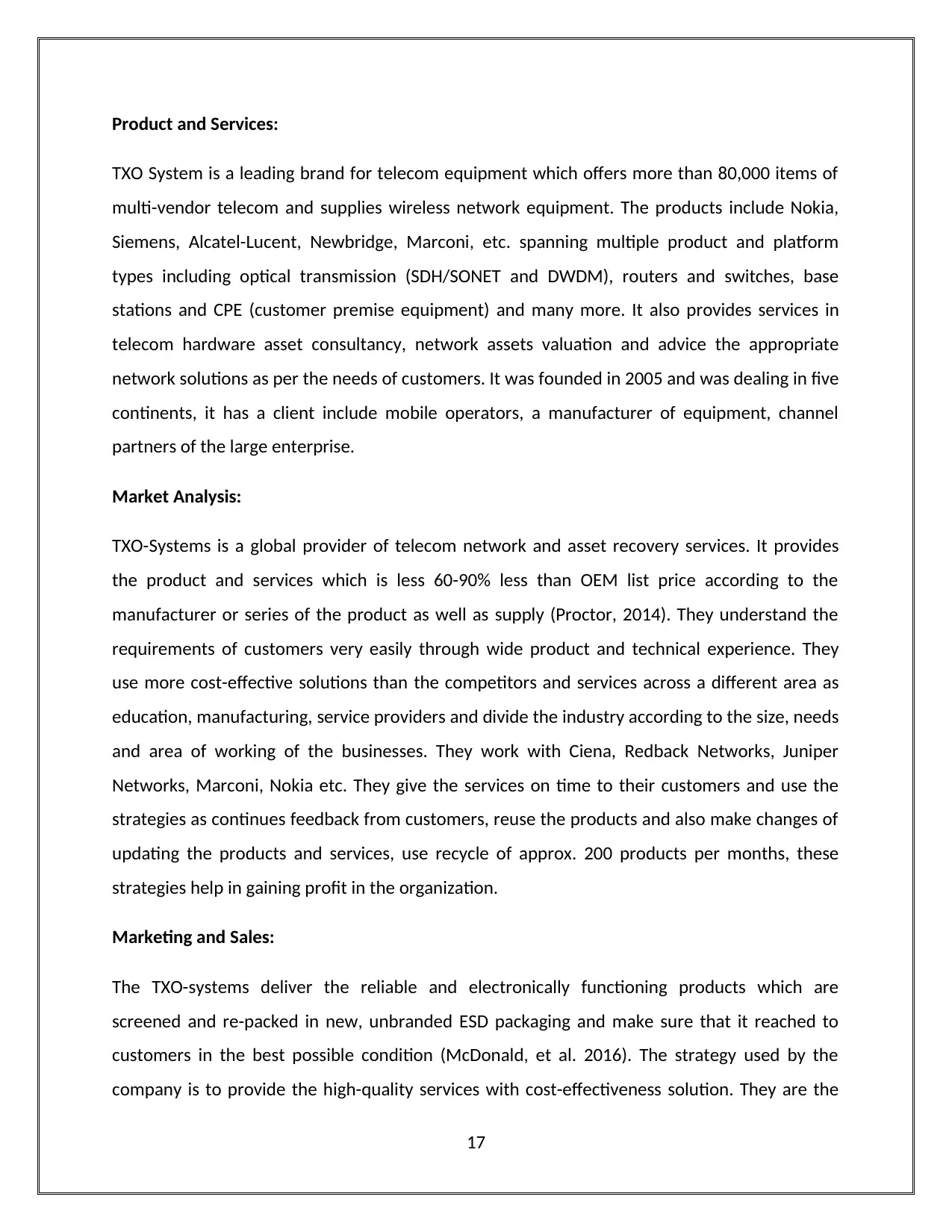
Product and Services:
TXO System is a leading brand for telecom equipment which offers more than 80,000 items of
multi-vendor telecom and supplies wireless network equipment. The products include Nokia,
Siemens, Alcatel-Lucent, Newbridge, Marconi, etc. spanning multiple product and platform
types including optical transmission (SDH/SONET and DWDM), routers and switches, base
stations and CPE (customer premise equipment) and many more. It also provides services in
telecom hardware asset consultancy, network assets valuation and advice the appropriate
network solutions as per the needs of customers. It was founded in 2005 and was dealing in five
continents, it has a client include mobile operators, a manufacturer of equipment, channel
partners of the large enterprise.
Market Analysis:
TXO-Systems is a global provider of telecom network and asset recovery services. It provides
the product and services which is less 60-90% less than OEM list price according to the
manufacturer or series of the product as well as supply (Proctor, 2014). They understand the
requirements of customers very easily through wide product and technical experience. They
use more cost-effective solutions than the competitors and services across a different area as
education, manufacturing, service providers and divide the industry according to the size, needs
and area of working of the businesses. They work with Ciena, Redback Networks, Juniper
Networks, Marconi, Nokia etc. They give the services on time to their customers and use the
strategies as continues feedback from customers, reuse the products and also make changes of
updating the products and services, use recycle of approx. 200 products per months, these
strategies help in gaining profit in the organization.
Marketing and Sales:
The TXO-systems deliver the reliable and electronically functioning products which are
screened and re-packed in new, unbranded ESD packaging and make sure that it reached to
customers in the best possible condition (McDonald, et al. 2016). The strategy used by the
company is to provide the high-quality services with cost-effectiveness solution. They are the
17
TXO System is a leading brand for telecom equipment which offers more than 80,000 items of
multi-vendor telecom and supplies wireless network equipment. The products include Nokia,
Siemens, Alcatel-Lucent, Newbridge, Marconi, etc. spanning multiple product and platform
types including optical transmission (SDH/SONET and DWDM), routers and switches, base
stations and CPE (customer premise equipment) and many more. It also provides services in
telecom hardware asset consultancy, network assets valuation and advice the appropriate
network solutions as per the needs of customers. It was founded in 2005 and was dealing in five
continents, it has a client include mobile operators, a manufacturer of equipment, channel
partners of the large enterprise.
Market Analysis:
TXO-Systems is a global provider of telecom network and asset recovery services. It provides
the product and services which is less 60-90% less than OEM list price according to the
manufacturer or series of the product as well as supply (Proctor, 2014). They understand the
requirements of customers very easily through wide product and technical experience. They
use more cost-effective solutions than the competitors and services across a different area as
education, manufacturing, service providers and divide the industry according to the size, needs
and area of working of the businesses. They work with Ciena, Redback Networks, Juniper
Networks, Marconi, Nokia etc. They give the services on time to their customers and use the
strategies as continues feedback from customers, reuse the products and also make changes of
updating the products and services, use recycle of approx. 200 products per months, these
strategies help in gaining profit in the organization.
Marketing and Sales:
The TXO-systems deliver the reliable and electronically functioning products which are
screened and re-packed in new, unbranded ESD packaging and make sure that it reached to
customers in the best possible condition (McDonald, et al. 2016). The strategy used by the
company is to provide the high-quality services with cost-effectiveness solution. They are the
17
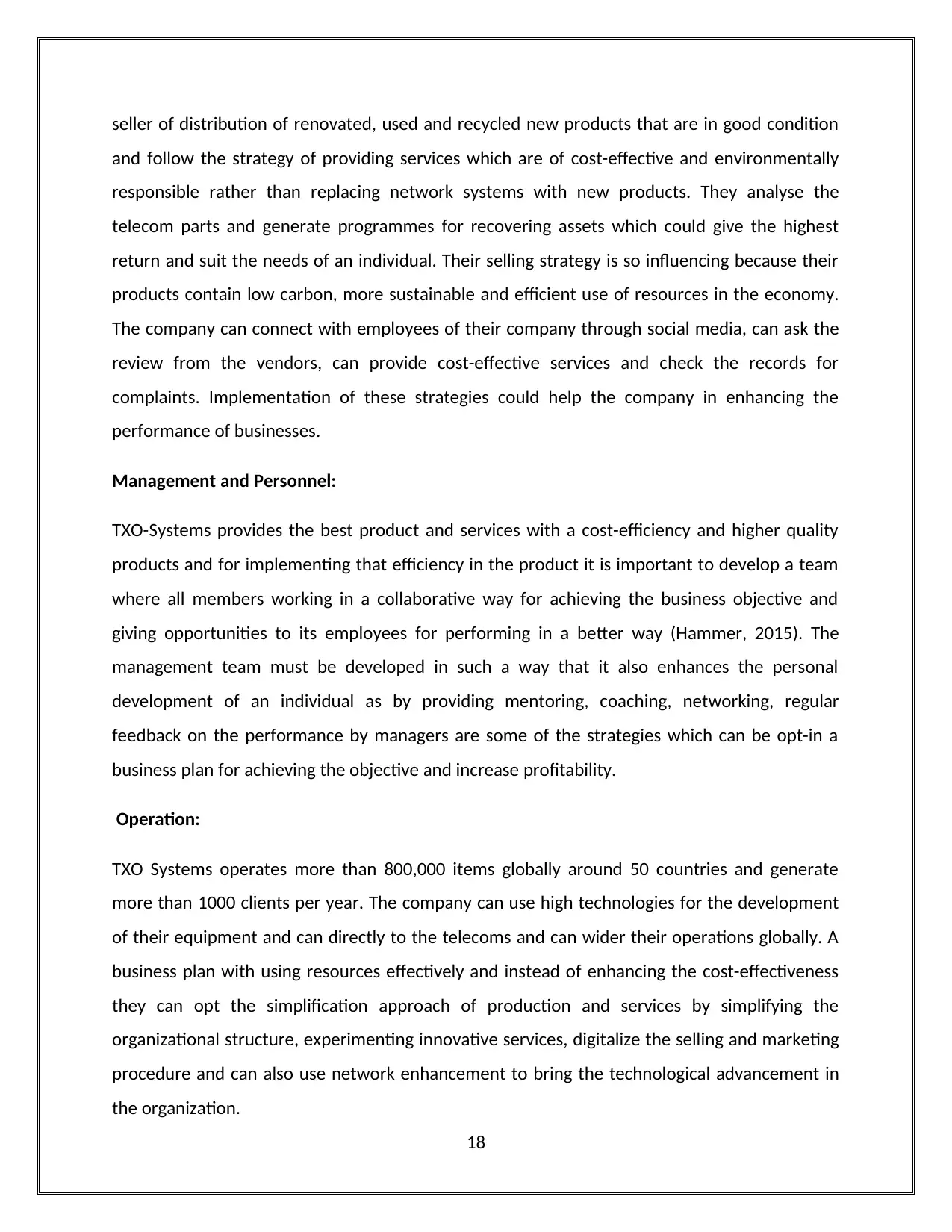
seller of distribution of renovated, used and recycled new products that are in good condition
and follow the strategy of providing services which are of cost-effective and environmentally
responsible rather than replacing network systems with new products. They analyse the
telecom parts and generate programmes for recovering assets which could give the highest
return and suit the needs of an individual. Their selling strategy is so influencing because their
products contain low carbon, more sustainable and efficient use of resources in the economy.
The company can connect with employees of their company through social media, can ask the
review from the vendors, can provide cost-effective services and check the records for
complaints. Implementation of these strategies could help the company in enhancing the
performance of businesses.
Management and Personnel:
TXO-Systems provides the best product and services with a cost-efficiency and higher quality
products and for implementing that efficiency in the product it is important to develop a team
where all members working in a collaborative way for achieving the business objective and
giving opportunities to its employees for performing in a better way (Hammer, 2015). The
management team must be developed in such a way that it also enhances the personal
development of an individual as by providing mentoring, coaching, networking, regular
feedback on the performance by managers are some of the strategies which can be opt-in a
business plan for achieving the objective and increase profitability.
Operation:
TXO Systems operates more than 800,000 items globally around 50 countries and generate
more than 1000 clients per year. The company can use high technologies for the development
of their equipment and can directly to the telecoms and can wider their operations globally. A
business plan with using resources effectively and instead of enhancing the cost-effectiveness
they can opt the simplification approach of production and services by simplifying the
organizational structure, experimenting innovative services, digitalize the selling and marketing
procedure and can also use network enhancement to bring the technological advancement in
the organization.
18
and follow the strategy of providing services which are of cost-effective and environmentally
responsible rather than replacing network systems with new products. They analyse the
telecom parts and generate programmes for recovering assets which could give the highest
return and suit the needs of an individual. Their selling strategy is so influencing because their
products contain low carbon, more sustainable and efficient use of resources in the economy.
The company can connect with employees of their company through social media, can ask the
review from the vendors, can provide cost-effective services and check the records for
complaints. Implementation of these strategies could help the company in enhancing the
performance of businesses.
Management and Personnel:
TXO-Systems provides the best product and services with a cost-efficiency and higher quality
products and for implementing that efficiency in the product it is important to develop a team
where all members working in a collaborative way for achieving the business objective and
giving opportunities to its employees for performing in a better way (Hammer, 2015). The
management team must be developed in such a way that it also enhances the personal
development of an individual as by providing mentoring, coaching, networking, regular
feedback on the performance by managers are some of the strategies which can be opt-in a
business plan for achieving the objective and increase profitability.
Operation:
TXO Systems operates more than 800,000 items globally around 50 countries and generate
more than 1000 clients per year. The company can use high technologies for the development
of their equipment and can directly to the telecoms and can wider their operations globally. A
business plan with using resources effectively and instead of enhancing the cost-effectiveness
they can opt the simplification approach of production and services by simplifying the
organizational structure, experimenting innovative services, digitalize the selling and marketing
procedure and can also use network enhancement to bring the technological advancement in
the organization.
18
Paraphrase This Document
Need a fresh take? Get an instant paraphrase of this document with our AI Paraphraser
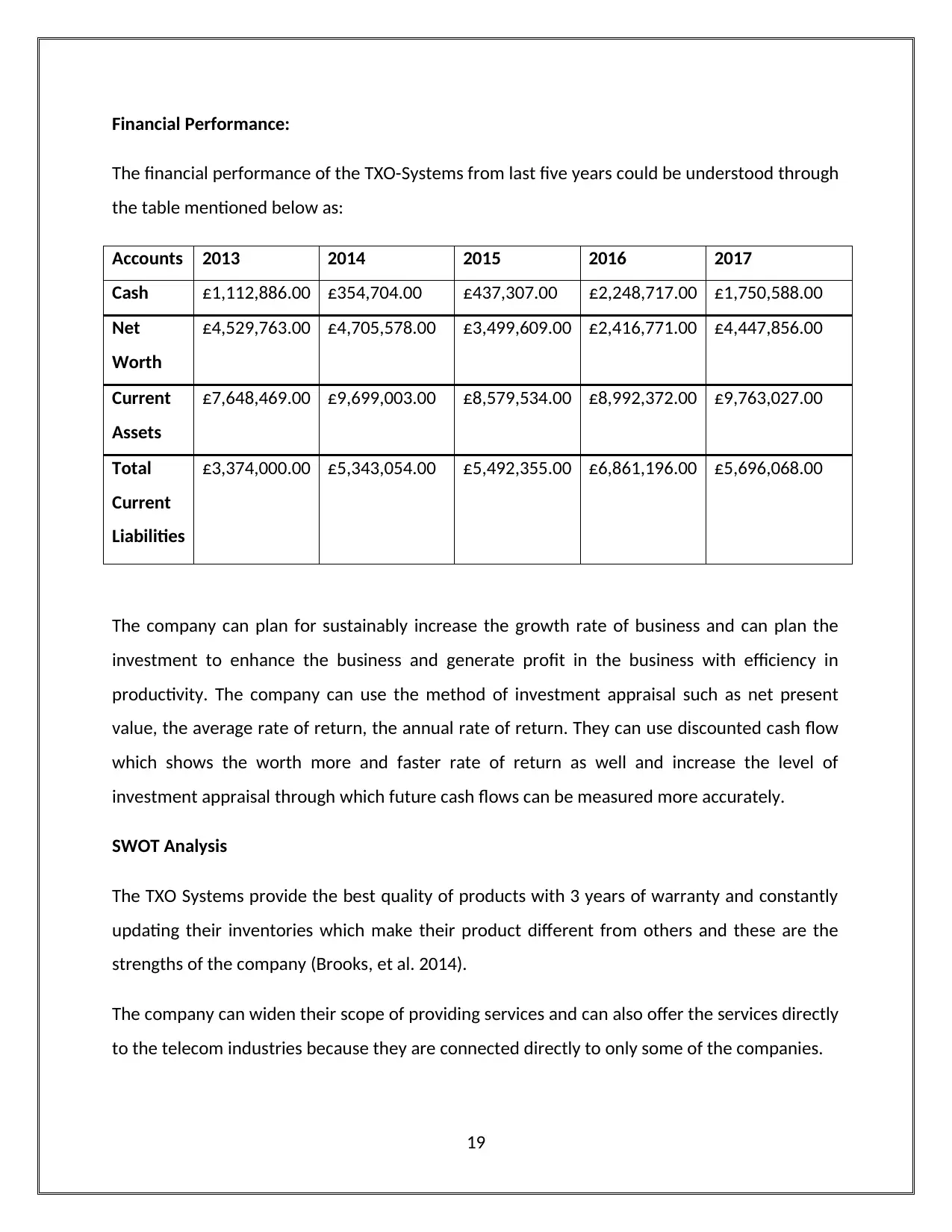
Financial Performance:
The financial performance of the TXO-Systems from last five years could be understood through
the table mentioned below as:
Accounts 2013 2014 2015 2016 2017
Cash £1,112,886.00 £354,704.00 £437,307.00 £2,248,717.00 £1,750,588.00
Net
Worth
£4,529,763.00 £4,705,578.00 £3,499,609.00 £2,416,771.00 £4,447,856.00
Current
Assets
£7,648,469.00 £9,699,003.00 £8,579,534.00 £8,992,372.00 £9,763,027.00
Total
Current
Liabilities
£3,374,000.00 £5,343,054.00 £5,492,355.00 £6,861,196.00 £5,696,068.00
The company can plan for sustainably increase the growth rate of business and can plan the
investment to enhance the business and generate profit in the business with efficiency in
productivity. The company can use the method of investment appraisal such as net present
value, the average rate of return, the annual rate of return. They can use discounted cash flow
which shows the worth more and faster rate of return as well and increase the level of
investment appraisal through which future cash flows can be measured more accurately.
SWOT Analysis
The TXO Systems provide the best quality of products with 3 years of warranty and constantly
updating their inventories which make their product different from others and these are the
strengths of the company (Brooks, et al. 2014).
The company can widen their scope of providing services and can also offer the services directly
to the telecom industries because they are connected directly to only some of the companies.
19
The financial performance of the TXO-Systems from last five years could be understood through
the table mentioned below as:
Accounts 2013 2014 2015 2016 2017
Cash £1,112,886.00 £354,704.00 £437,307.00 £2,248,717.00 £1,750,588.00
Net
Worth
£4,529,763.00 £4,705,578.00 £3,499,609.00 £2,416,771.00 £4,447,856.00
Current
Assets
£7,648,469.00 £9,699,003.00 £8,579,534.00 £8,992,372.00 £9,763,027.00
Total
Current
Liabilities
£3,374,000.00 £5,343,054.00 £5,492,355.00 £6,861,196.00 £5,696,068.00
The company can plan for sustainably increase the growth rate of business and can plan the
investment to enhance the business and generate profit in the business with efficiency in
productivity. The company can use the method of investment appraisal such as net present
value, the average rate of return, the annual rate of return. They can use discounted cash flow
which shows the worth more and faster rate of return as well and increase the level of
investment appraisal through which future cash flows can be measured more accurately.
SWOT Analysis
The TXO Systems provide the best quality of products with 3 years of warranty and constantly
updating their inventories which make their product different from others and these are the
strengths of the company (Brooks, et al. 2014).
The company can widen their scope of providing services and can also offer the services directly
to the telecom industries because they are connected directly to only some of the companies.
19
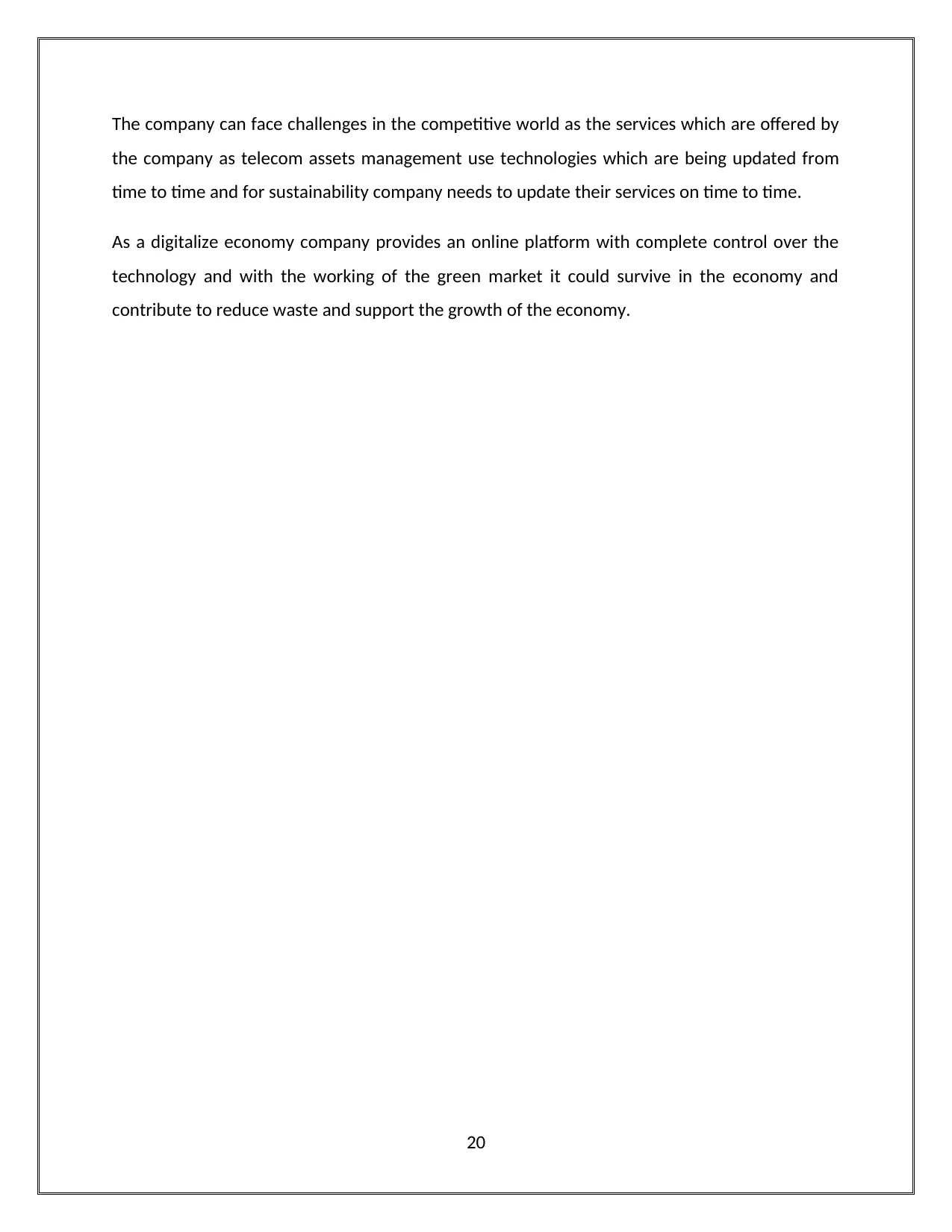
The company can face challenges in the competitive world as the services which are offered by
the company as telecom assets management use technologies which are being updated from
time to time and for sustainability company needs to update their services on time to time.
As a digitalize economy company provides an online platform with complete control over the
technology and with the working of the green market it could survive in the economy and
contribute to reduce waste and support the growth of the economy.
20
the company as telecom assets management use technologies which are being updated from
time to time and for sustainability company needs to update their services on time to time.
As a digitalize economy company provides an online platform with complete control over the
technology and with the working of the green market it could survive in the economy and
contribute to reduce waste and support the growth of the economy.
20
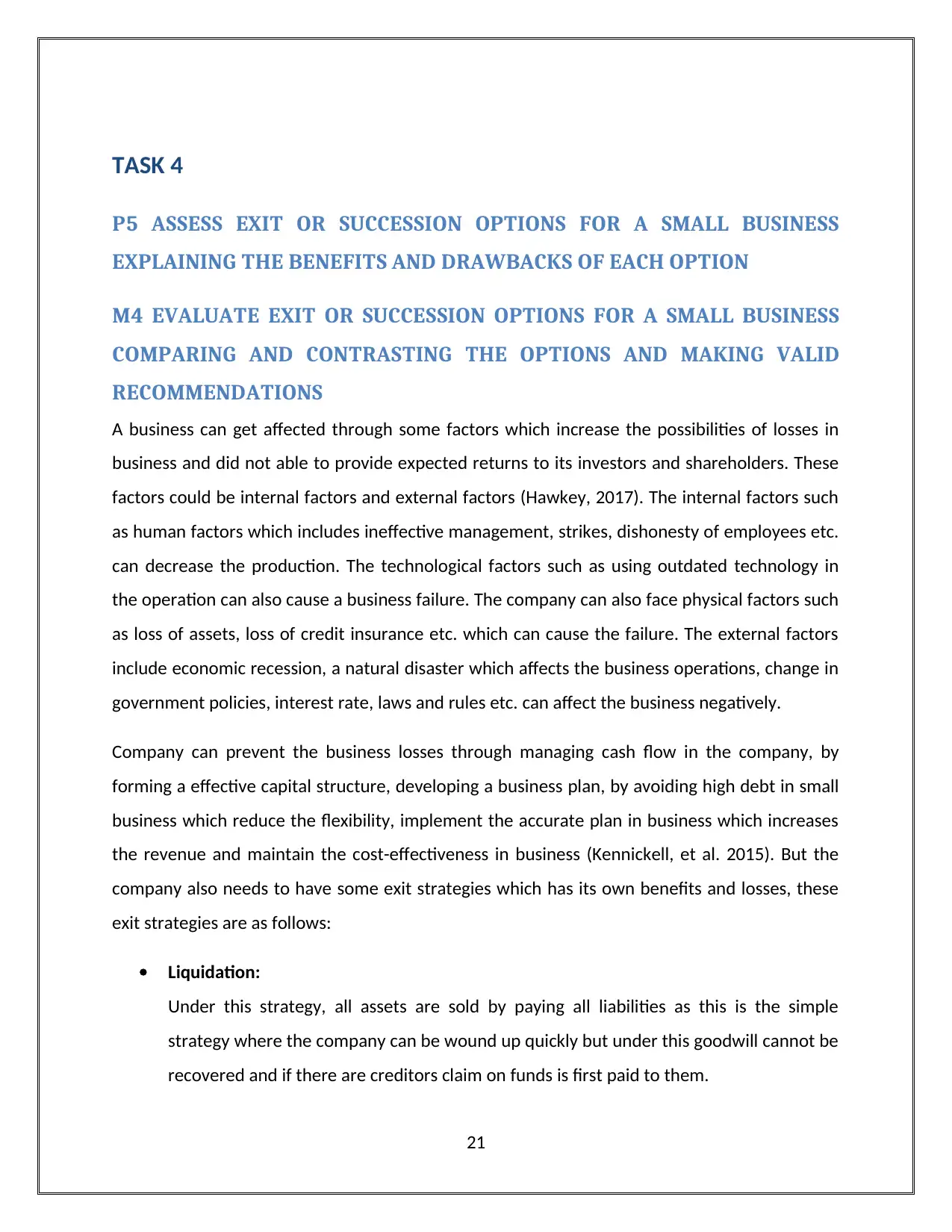
TASK 4
P5 ASSESS EXIT OR SUCCESSION OPTIONS FOR A SMALL BUSINESS
EXPLAINING THE BENEFITS AND DRAWBACKS OF EACH OPTION
M4 EVALUATE EXIT OR SUCCESSION OPTIONS FOR A SMALL BUSINESS
COMPARING AND CONTRASTING THE OPTIONS AND MAKING VALID
RECOMMENDATIONS
A business can get affected through some factors which increase the possibilities of losses in
business and did not able to provide expected returns to its investors and shareholders. These
factors could be internal factors and external factors (Hawkey, 2017). The internal factors such
as human factors which includes ineffective management, strikes, dishonesty of employees etc.
can decrease the production. The technological factors such as using outdated technology in
the operation can also cause a business failure. The company can also face physical factors such
as loss of assets, loss of credit insurance etc. which can cause the failure. The external factors
include economic recession, a natural disaster which affects the business operations, change in
government policies, interest rate, laws and rules etc. can affect the business negatively.
Company can prevent the business losses through managing cash flow in the company, by
forming a effective capital structure, developing a business plan, by avoiding high debt in small
business which reduce the flexibility, implement the accurate plan in business which increases
the revenue and maintain the cost-effectiveness in business (Kennickell, et al. 2015). But the
company also needs to have some exit strategies which has its own benefits and losses, these
exit strategies are as follows:
Liquidation:
Under this strategy, all assets are sold by paying all liabilities as this is the simple
strategy where the company can be wound up quickly but under this goodwill cannot be
recovered and if there are creditors claim on funds is first paid to them.
21
P5 ASSESS EXIT OR SUCCESSION OPTIONS FOR A SMALL BUSINESS
EXPLAINING THE BENEFITS AND DRAWBACKS OF EACH OPTION
M4 EVALUATE EXIT OR SUCCESSION OPTIONS FOR A SMALL BUSINESS
COMPARING AND CONTRASTING THE OPTIONS AND MAKING VALID
RECOMMENDATIONS
A business can get affected through some factors which increase the possibilities of losses in
business and did not able to provide expected returns to its investors and shareholders. These
factors could be internal factors and external factors (Hawkey, 2017). The internal factors such
as human factors which includes ineffective management, strikes, dishonesty of employees etc.
can decrease the production. The technological factors such as using outdated technology in
the operation can also cause a business failure. The company can also face physical factors such
as loss of assets, loss of credit insurance etc. which can cause the failure. The external factors
include economic recession, a natural disaster which affects the business operations, change in
government policies, interest rate, laws and rules etc. can affect the business negatively.
Company can prevent the business losses through managing cash flow in the company, by
forming a effective capital structure, developing a business plan, by avoiding high debt in small
business which reduce the flexibility, implement the accurate plan in business which increases
the revenue and maintain the cost-effectiveness in business (Kennickell, et al. 2015). But the
company also needs to have some exit strategies which has its own benefits and losses, these
exit strategies are as follows:
Liquidation:
Under this strategy, all assets are sold by paying all liabilities as this is the simple
strategy where the company can be wound up quickly but under this goodwill cannot be
recovered and if there are creditors claim on funds is first paid to them.
21
Secure Best Marks with AI Grader
Need help grading? Try our AI Grader for instant feedback on your assignments.
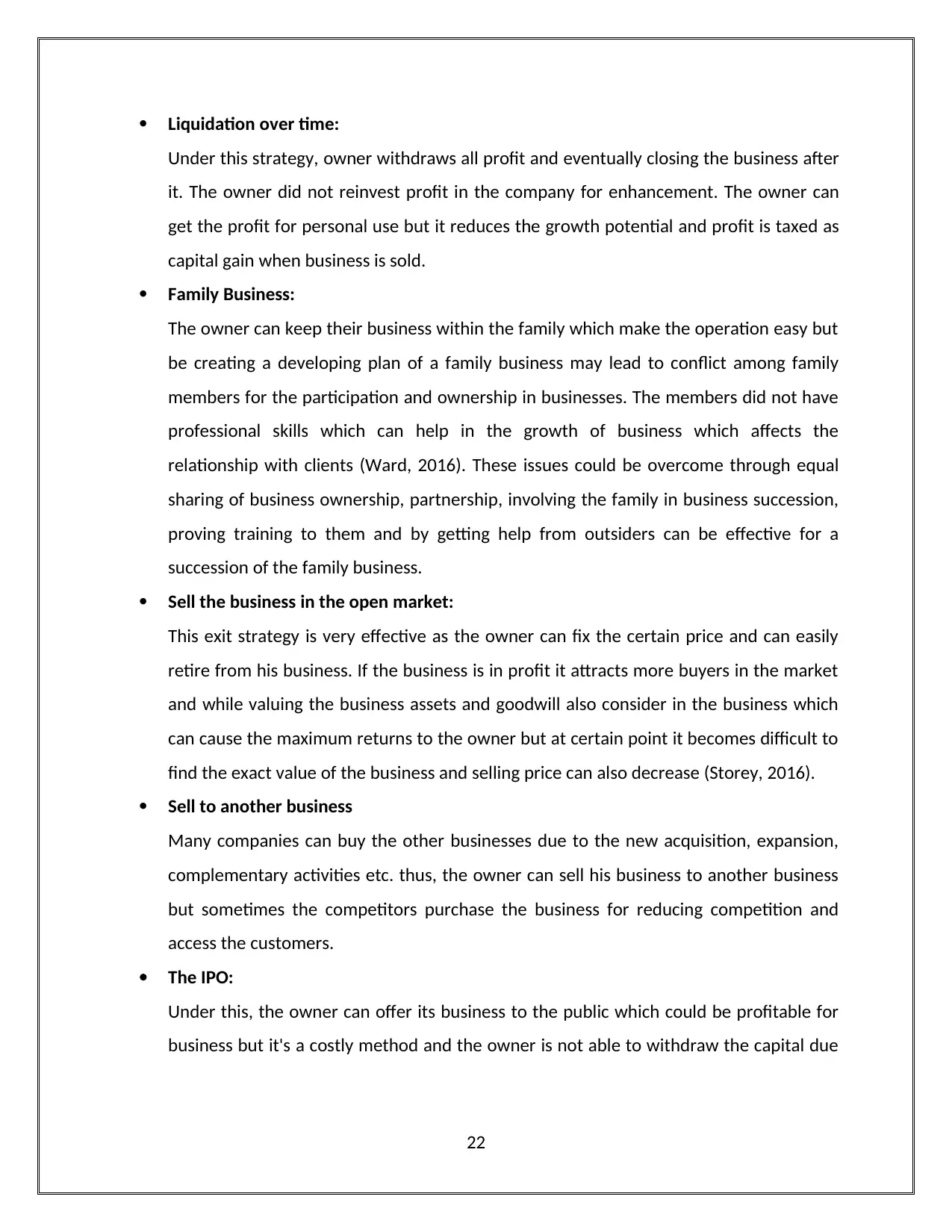
Liquidation over time:
Under this strategy, owner withdraws all profit and eventually closing the business after
it. The owner did not reinvest profit in the company for enhancement. The owner can
get the profit for personal use but it reduces the growth potential and profit is taxed as
capital gain when business is sold.
Family Business:
The owner can keep their business within the family which make the operation easy but
be creating a developing plan of a family business may lead to conflict among family
members for the participation and ownership in businesses. The members did not have
professional skills which can help in the growth of business which affects the
relationship with clients (Ward, 2016). These issues could be overcome through equal
sharing of business ownership, partnership, involving the family in business succession,
proving training to them and by getting help from outsiders can be effective for a
succession of the family business.
Sell the business in the open market:
This exit strategy is very effective as the owner can fix the certain price and can easily
retire from his business. If the business is in profit it attracts more buyers in the market
and while valuing the business assets and goodwill also consider in the business which
can cause the maximum returns to the owner but at certain point it becomes difficult to
find the exact value of the business and selling price can also decrease (Storey, 2016).
Sell to another business
Many companies can buy the other businesses due to the new acquisition, expansion,
complementary activities etc. thus, the owner can sell his business to another business
but sometimes the competitors purchase the business for reducing competition and
access the customers.
The IPO:
Under this, the owner can offer its business to the public which could be profitable for
business but it's a costly method and the owner is not able to withdraw the capital due
22
Under this strategy, owner withdraws all profit and eventually closing the business after
it. The owner did not reinvest profit in the company for enhancement. The owner can
get the profit for personal use but it reduces the growth potential and profit is taxed as
capital gain when business is sold.
Family Business:
The owner can keep their business within the family which make the operation easy but
be creating a developing plan of a family business may lead to conflict among family
members for the participation and ownership in businesses. The members did not have
professional skills which can help in the growth of business which affects the
relationship with clients (Ward, 2016). These issues could be overcome through equal
sharing of business ownership, partnership, involving the family in business succession,
proving training to them and by getting help from outsiders can be effective for a
succession of the family business.
Sell the business in the open market:
This exit strategy is very effective as the owner can fix the certain price and can easily
retire from his business. If the business is in profit it attracts more buyers in the market
and while valuing the business assets and goodwill also consider in the business which
can cause the maximum returns to the owner but at certain point it becomes difficult to
find the exact value of the business and selling price can also decrease (Storey, 2016).
Sell to another business
Many companies can buy the other businesses due to the new acquisition, expansion,
complementary activities etc. thus, the owner can sell his business to another business
but sometimes the competitors purchase the business for reducing competition and
access the customers.
The IPO:
Under this, the owner can offer its business to the public which could be profitable for
business but it's a costly method and the owner is not able to withdraw the capital due
22
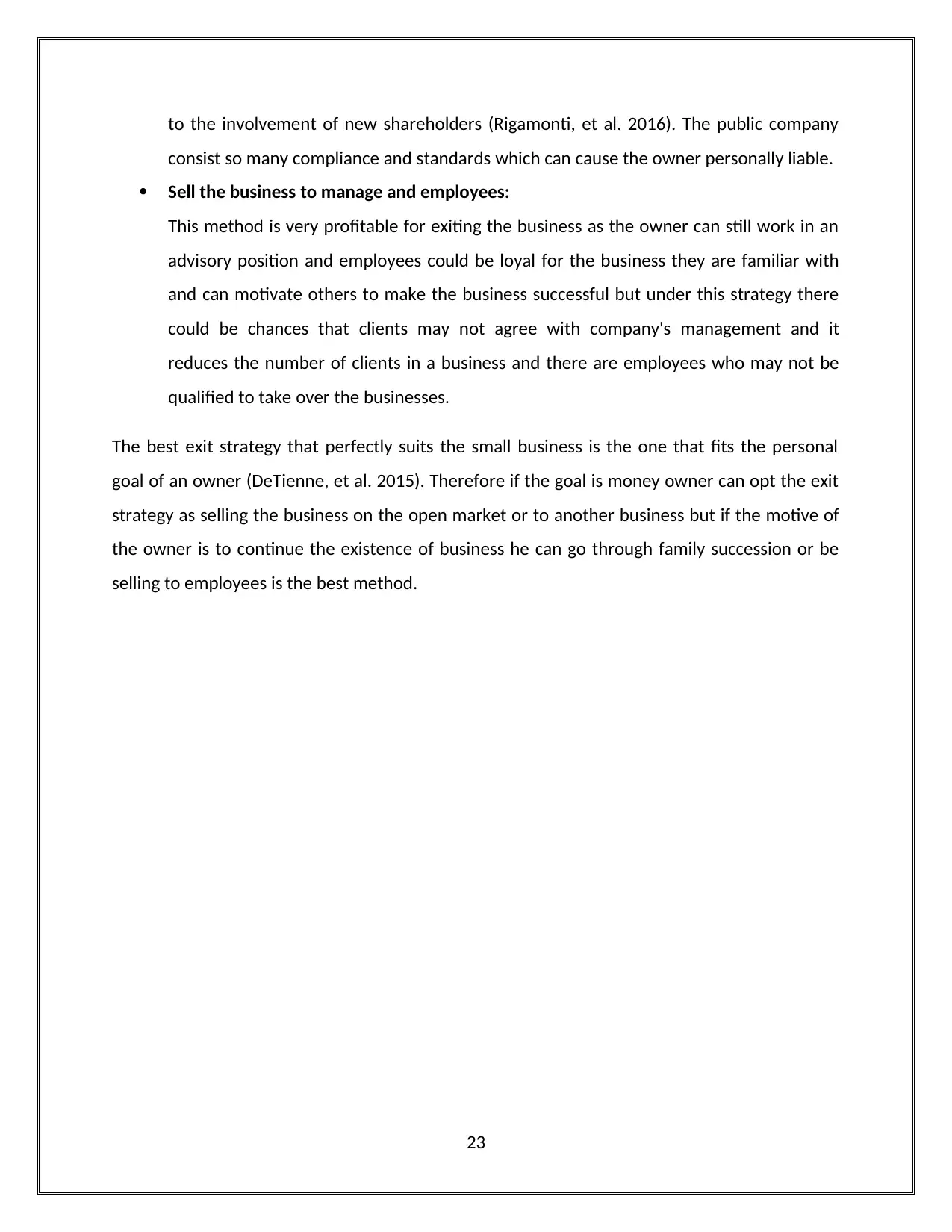
to the involvement of new shareholders (Rigamonti, et al. 2016). The public company
consist so many compliance and standards which can cause the owner personally liable.
Sell the business to manage and employees:
This method is very profitable for exiting the business as the owner can still work in an
advisory position and employees could be loyal for the business they are familiar with
and can motivate others to make the business successful but under this strategy there
could be chances that clients may not agree with company's management and it
reduces the number of clients in a business and there are employees who may not be
qualified to take over the businesses.
The best exit strategy that perfectly suits the small business is the one that fits the personal
goal of an owner (DeTienne, et al. 2015). Therefore if the goal is money owner can opt the exit
strategy as selling the business on the open market or to another business but if the motive of
the owner is to continue the existence of business he can go through family succession or be
selling to employees is the best method.
23
consist so many compliance and standards which can cause the owner personally liable.
Sell the business to manage and employees:
This method is very profitable for exiting the business as the owner can still work in an
advisory position and employees could be loyal for the business they are familiar with
and can motivate others to make the business successful but under this strategy there
could be chances that clients may not agree with company's management and it
reduces the number of clients in a business and there are employees who may not be
qualified to take over the businesses.
The best exit strategy that perfectly suits the small business is the one that fits the personal
goal of an owner (DeTienne, et al. 2015). Therefore if the goal is money owner can opt the exit
strategy as selling the business on the open market or to another business but if the motive of
the owner is to continue the existence of business he can go through family succession or be
selling to employees is the best method.
23
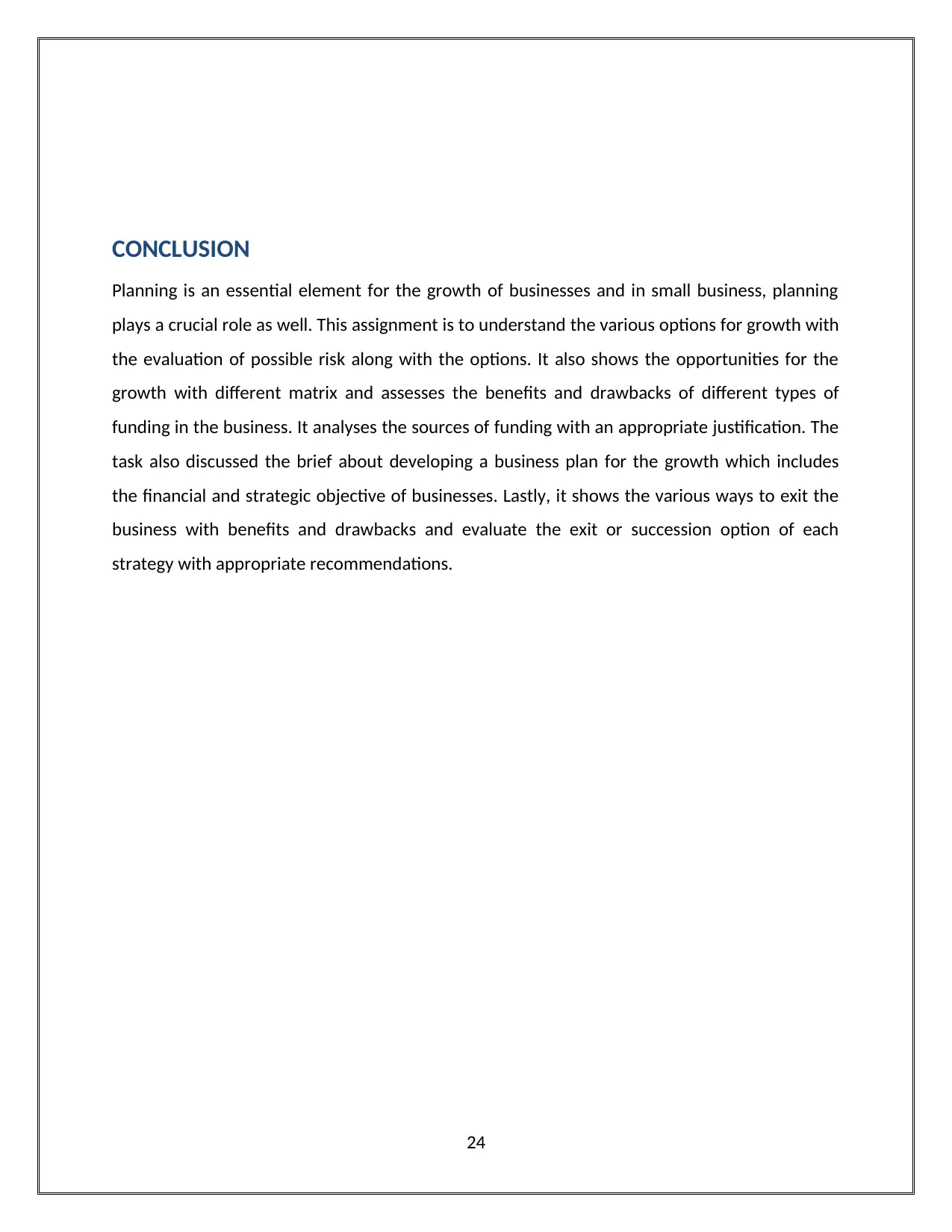
CONCLUSION
Planning is an essential element for the growth of businesses and in small business, planning
plays a crucial role as well. This assignment is to understand the various options for growth with
the evaluation of possible risk along with the options. It also shows the opportunities for the
growth with different matrix and assesses the benefits and drawbacks of different types of
funding in the business. It analyses the sources of funding with an appropriate justification. The
task also discussed the brief about developing a business plan for the growth which includes
the financial and strategic objective of businesses. Lastly, it shows the various ways to exit the
business with benefits and drawbacks and evaluate the exit or succession option of each
strategy with appropriate recommendations.
24
Planning is an essential element for the growth of businesses and in small business, planning
plays a crucial role as well. This assignment is to understand the various options for growth with
the evaluation of possible risk along with the options. It also shows the opportunities for the
growth with different matrix and assesses the benefits and drawbacks of different types of
funding in the business. It analyses the sources of funding with an appropriate justification. The
task also discussed the brief about developing a business plan for the growth which includes
the financial and strategic objective of businesses. Lastly, it shows the various ways to exit the
business with benefits and drawbacks and evaluate the exit or succession option of each
strategy with appropriate recommendations.
24
Paraphrase This Document
Need a fresh take? Get an instant paraphrase of this document with our AI Paraphraser
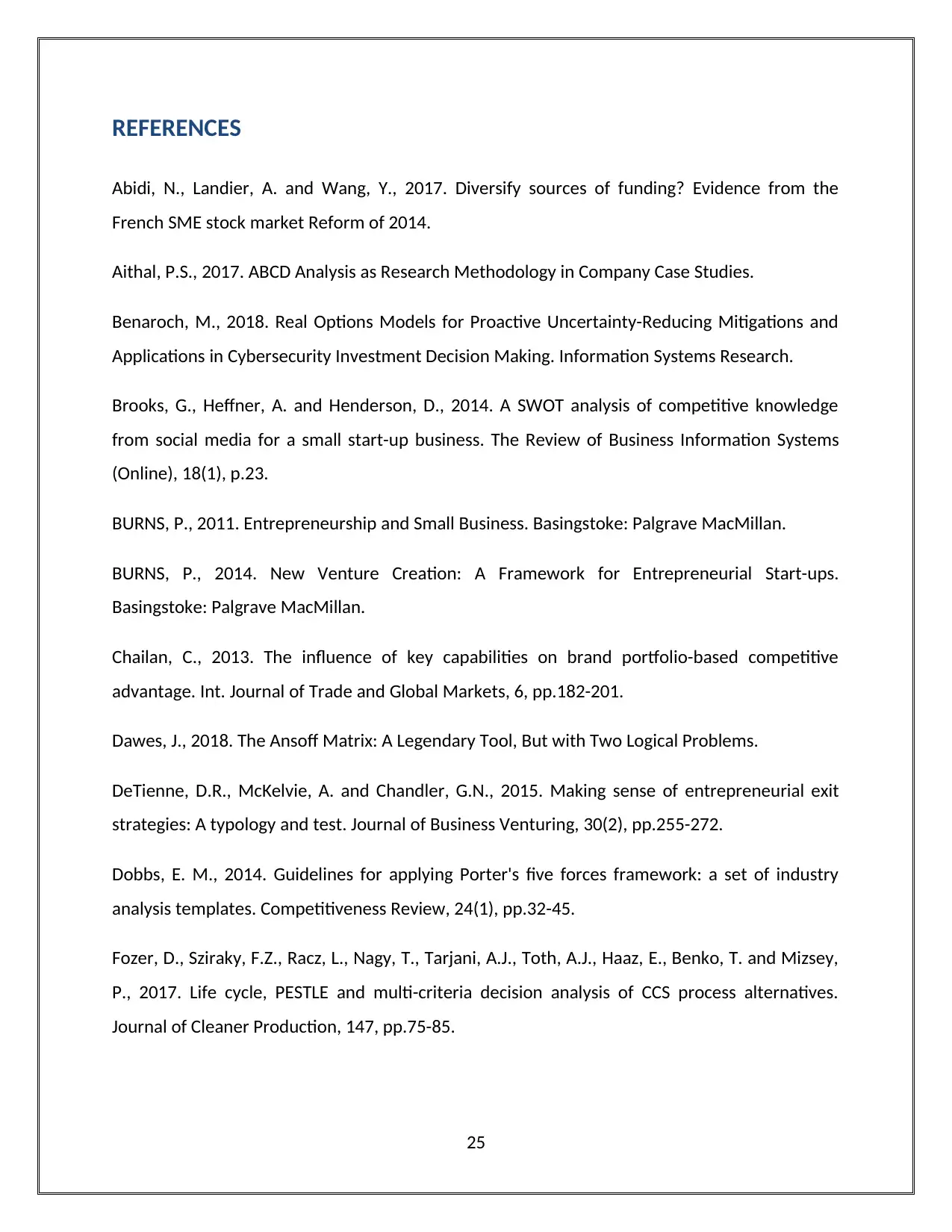
REFERENCES
Abidi, N., Landier, A. and Wang, Y., 2017. Diversify sources of funding? Evidence from the
French SME stock market Reform of 2014.
Aithal, P.S., 2017. ABCD Analysis as Research Methodology in Company Case Studies.
Benaroch, M., 2018. Real Options Models for Proactive Uncertainty-Reducing Mitigations and
Applications in Cybersecurity Investment Decision Making. Information Systems Research.
Brooks, G., Heffner, A. and Henderson, D., 2014. A SWOT analysis of competitive knowledge
from social media for a small start-up business. The Review of Business Information Systems
(Online), 18(1), p.23.
BURNS, P., 2011. Entrepreneurship and Small Business. Basingstoke: Palgrave MacMillan.
BURNS, P., 2014. New Venture Creation: A Framework for Entrepreneurial Start-ups.
Basingstoke: Palgrave MacMillan.
Chailan, C., 2013. The influence of key capabilities on brand portfolio-based competitive
advantage. Int. Journal of Trade and Global Markets, 6, pp.182-201.
Dawes, J., 2018. The Ansoff Matrix: A Legendary Tool, But with Two Logical Problems.
DeTienne, D.R., McKelvie, A. and Chandler, G.N., 2015. Making sense of entrepreneurial exit
strategies: A typology and test. Journal of Business Venturing, 30(2), pp.255-272.
Dobbs, E. M., 2014. Guidelines for applying Porter's five forces framework: a set of industry
analysis templates. Competitiveness Review, 24(1), pp.32-45.
Fozer, D., Sziraky, F.Z., Racz, L., Nagy, T., Tarjani, A.J., Toth, A.J., Haaz, E., Benko, T. and Mizsey,
P., 2017. Life cycle, PESTLE and multi-criteria decision analysis of CCS process alternatives.
Journal of Cleaner Production, 147, pp.75-85.
25
Abidi, N., Landier, A. and Wang, Y., 2017. Diversify sources of funding? Evidence from the
French SME stock market Reform of 2014.
Aithal, P.S., 2017. ABCD Analysis as Research Methodology in Company Case Studies.
Benaroch, M., 2018. Real Options Models for Proactive Uncertainty-Reducing Mitigations and
Applications in Cybersecurity Investment Decision Making. Information Systems Research.
Brooks, G., Heffner, A. and Henderson, D., 2014. A SWOT analysis of competitive knowledge
from social media for a small start-up business. The Review of Business Information Systems
(Online), 18(1), p.23.
BURNS, P., 2011. Entrepreneurship and Small Business. Basingstoke: Palgrave MacMillan.
BURNS, P., 2014. New Venture Creation: A Framework for Entrepreneurial Start-ups.
Basingstoke: Palgrave MacMillan.
Chailan, C., 2013. The influence of key capabilities on brand portfolio-based competitive
advantage. Int. Journal of Trade and Global Markets, 6, pp.182-201.
Dawes, J., 2018. The Ansoff Matrix: A Legendary Tool, But with Two Logical Problems.
DeTienne, D.R., McKelvie, A. and Chandler, G.N., 2015. Making sense of entrepreneurial exit
strategies: A typology and test. Journal of Business Venturing, 30(2), pp.255-272.
Dobbs, E. M., 2014. Guidelines for applying Porter's five forces framework: a set of industry
analysis templates. Competitiveness Review, 24(1), pp.32-45.
Fozer, D., Sziraky, F.Z., Racz, L., Nagy, T., Tarjani, A.J., Toth, A.J., Haaz, E., Benko, T. and Mizsey,
P., 2017. Life cycle, PESTLE and multi-criteria decision analysis of CCS process alternatives.
Journal of Cleaner Production, 147, pp.75-85.
25
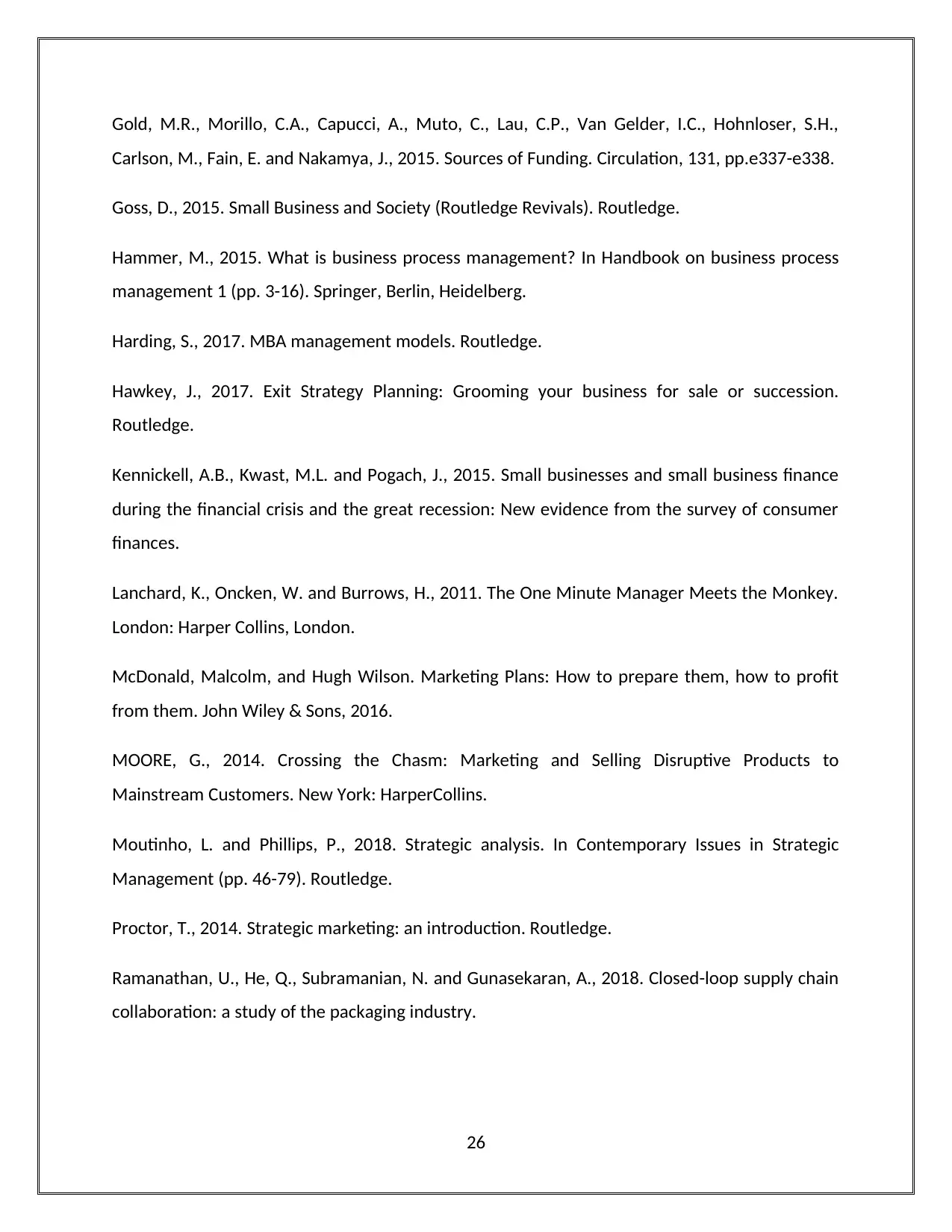
Gold, M.R., Morillo, C.A., Capucci, A., Muto, C., Lau, C.P., Van Gelder, I.C., Hohnloser, S.H.,
Carlson, M., Fain, E. and Nakamya, J., 2015. Sources of Funding. Circulation, 131, pp.e337-e338.
Goss, D., 2015. Small Business and Society (Routledge Revivals). Routledge.
Hammer, M., 2015. What is business process management? In Handbook on business process
management 1 (pp. 3-16). Springer, Berlin, Heidelberg.
Harding, S., 2017. MBA management models. Routledge.
Hawkey, J., 2017. Exit Strategy Planning: Grooming your business for sale or succession.
Routledge.
Kennickell, A.B., Kwast, M.L. and Pogach, J., 2015. Small businesses and small business finance
during the financial crisis and the great recession: New evidence from the survey of consumer
finances.
Lanchard, K., Oncken, W. and Burrows, H., 2011. The One Minute Manager Meets the Monkey.
London: Harper Collins, London.
McDonald, Malcolm, and Hugh Wilson. Marketing Plans: How to prepare them, how to profit
from them. John Wiley & Sons, 2016.
MOORE, G., 2014. Crossing the Chasm: Marketing and Selling Disruptive Products to
Mainstream Customers. New York: HarperCollins.
Moutinho, L. and Phillips, P., 2018. Strategic analysis. In Contemporary Issues in Strategic
Management (pp. 46-79). Routledge.
Proctor, T., 2014. Strategic marketing: an introduction. Routledge.
Ramanathan, U., He, Q., Subramanian, N. and Gunasekaran, A., 2018. Closed-loop supply chain
collaboration: a study of the packaging industry.
26
Carlson, M., Fain, E. and Nakamya, J., 2015. Sources of Funding. Circulation, 131, pp.e337-e338.
Goss, D., 2015. Small Business and Society (Routledge Revivals). Routledge.
Hammer, M., 2015. What is business process management? In Handbook on business process
management 1 (pp. 3-16). Springer, Berlin, Heidelberg.
Harding, S., 2017. MBA management models. Routledge.
Hawkey, J., 2017. Exit Strategy Planning: Grooming your business for sale or succession.
Routledge.
Kennickell, A.B., Kwast, M.L. and Pogach, J., 2015. Small businesses and small business finance
during the financial crisis and the great recession: New evidence from the survey of consumer
finances.
Lanchard, K., Oncken, W. and Burrows, H., 2011. The One Minute Manager Meets the Monkey.
London: Harper Collins, London.
McDonald, Malcolm, and Hugh Wilson. Marketing Plans: How to prepare them, how to profit
from them. John Wiley & Sons, 2016.
MOORE, G., 2014. Crossing the Chasm: Marketing and Selling Disruptive Products to
Mainstream Customers. New York: HarperCollins.
Moutinho, L. and Phillips, P., 2018. Strategic analysis. In Contemporary Issues in Strategic
Management (pp. 46-79). Routledge.
Proctor, T., 2014. Strategic marketing: an introduction. Routledge.
Ramanathan, U., He, Q., Subramanian, N. and Gunasekaran, A., 2018. Closed-loop supply chain
collaboration: a study of the packaging industry.
26
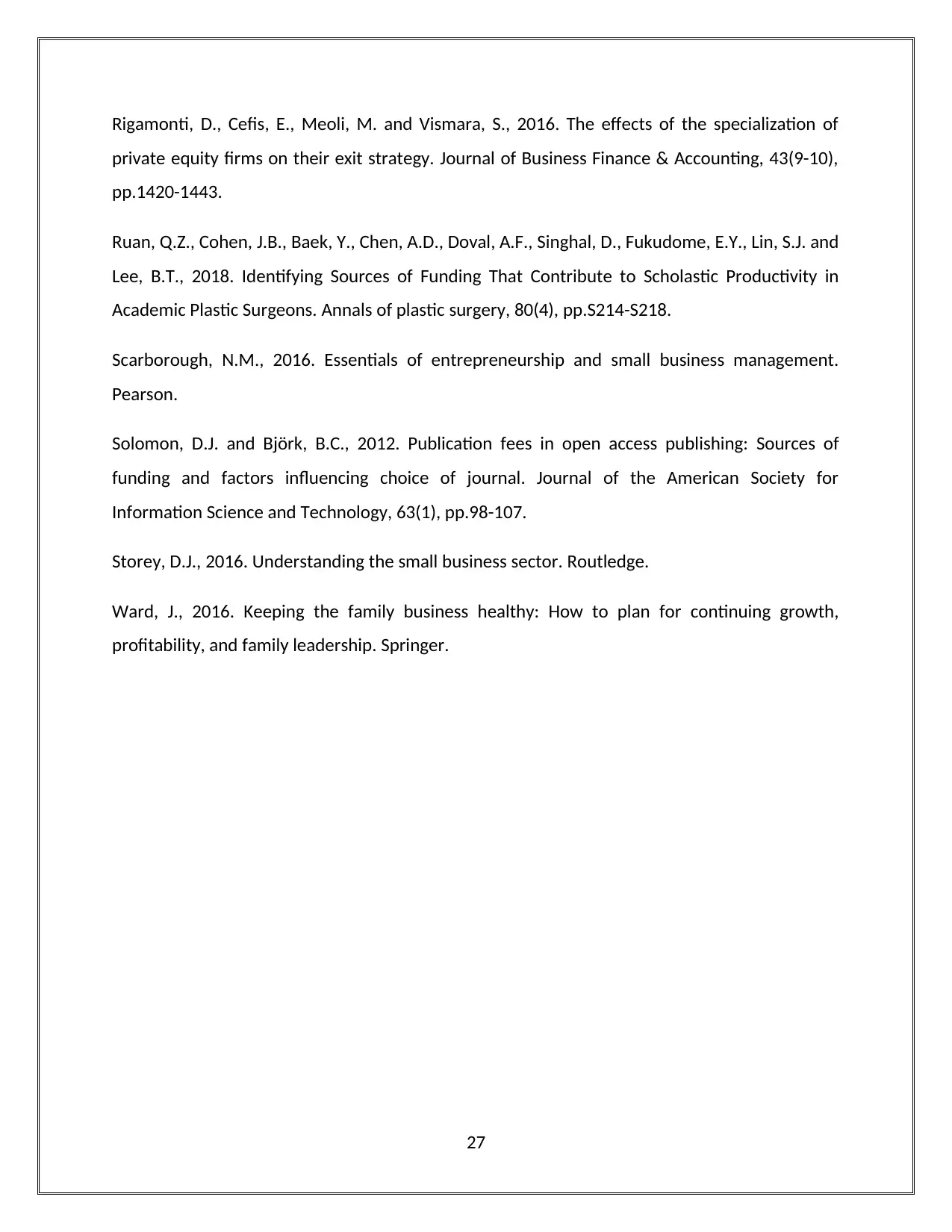
Rigamonti, D., Cefis, E., Meoli, M. and Vismara, S., 2016. The effects of the specialization of
private equity firms on their exit strategy. Journal of Business Finance & Accounting, 43(9-10),
pp.1420-1443.
Ruan, Q.Z., Cohen, J.B., Baek, Y., Chen, A.D., Doval, A.F., Singhal, D., Fukudome, E.Y., Lin, S.J. and
Lee, B.T., 2018. Identifying Sources of Funding That Contribute to Scholastic Productivity in
Academic Plastic Surgeons. Annals of plastic surgery, 80(4), pp.S214-S218.
Scarborough, N.M., 2016. Essentials of entrepreneurship and small business management.
Pearson.
Solomon, D.J. and Björk, B.C., 2012. Publication fees in open access publishing: Sources of
funding and factors influencing choice of journal. Journal of the American Society for
Information Science and Technology, 63(1), pp.98-107.
Storey, D.J., 2016. Understanding the small business sector. Routledge.
Ward, J., 2016. Keeping the family business healthy: How to plan for continuing growth,
profitability, and family leadership. Springer.
27
private equity firms on their exit strategy. Journal of Business Finance & Accounting, 43(9-10),
pp.1420-1443.
Ruan, Q.Z., Cohen, J.B., Baek, Y., Chen, A.D., Doval, A.F., Singhal, D., Fukudome, E.Y., Lin, S.J. and
Lee, B.T., 2018. Identifying Sources of Funding That Contribute to Scholastic Productivity in
Academic Plastic Surgeons. Annals of plastic surgery, 80(4), pp.S214-S218.
Scarborough, N.M., 2016. Essentials of entrepreneurship and small business management.
Pearson.
Solomon, D.J. and Björk, B.C., 2012. Publication fees in open access publishing: Sources of
funding and factors influencing choice of journal. Journal of the American Society for
Information Science and Technology, 63(1), pp.98-107.
Storey, D.J., 2016. Understanding the small business sector. Routledge.
Ward, J., 2016. Keeping the family business healthy: How to plan for continuing growth,
profitability, and family leadership. Springer.
27
1 out of 28
Related Documents
Your All-in-One AI-Powered Toolkit for Academic Success.
+13062052269
info@desklib.com
Available 24*7 on WhatsApp / Email
![[object Object]](/_next/static/media/star-bottom.7253800d.svg)
Unlock your academic potential
© 2024 | Zucol Services PVT LTD | All rights reserved.





